Winter is a magical time for bird enthusiasts in Texas, as the state becomes a haven for many migratory species seeking respite from the frigid temperatures further north.
From the vibrant colors of the painted bunting to the majestic flight of the sandhill crane, Texas offers a diverse and captivating experience for birdwatchers during the winter season.
As the landscaping is adorned with frost and snow, the bustling sounds of chirping and fluttering fill the air and provide a mesmerizing spectacle that brings joy to seasoned birdwatchers and curious nature lovers alike.
This article will explore the fascinating world of winter birds in Texas, their unique behaviors, and the best places to spot them in their transient stopovers across the Lone Star State.
So grab your binoculars, bundle up, and join us on this delightful journey into the winter wonderland of avian life in Texas.
49 Winter Birds in Texas
Winter is a magical time for bird enthusiasts in Texas, as the state becomes a haven for many migratory species seeking respite from the frigid temperatures further north.
Texas is home to a diverse array of bird species, including many that can be observed during winter.
Here’s a list of 49 winter birds that you might find in Texas:
1. Northern Cardinal
The northern cardinal is a bird commonly referred to by different names, such as redbird, common cardinal, red cardinal, or simply cardinal.
It belongs to the genus Cardinalis. The cardinal is primarily found in North America, particularly in regions such as the United States, Canada, and Mexico. It is known for its vibrant red plumage, which is more prominent in males than females.
The male cardinal has a distinctive crest on its head, while the female has a reddish tinge on its feathers. These birds are often observed in various habitats, including woodlands, gardens, and urban areas.
They adapt to different environments and thrive in rural and suburban settings.
Cardinals are also known for their beautiful songs, which are melodic and often used for communication and territorial marking. In terms of diet, the cardinal is omnivorous, meaning it eats various foods.
Its diet comprises seeds, fruits, insects, and occasionally small reptiles or amphibians.
They have a strong beak that allows them to crack open seeds and fruits easily. Cardinals engage in courtship rituals during the breeding season, which typically occurs in spring and early summer. The male cardinal displays its vibrant red plum.
| Kingdom | Animalia |
| Phylum | Chordata |
| Clade | Dinosauria |
| Class | Aves |
| Order | Passeriformes |
| Family | Cardinalidae |
| Genus | Cardinalis |
| Species | C. cardinalis |
2. Northern Mockingbird
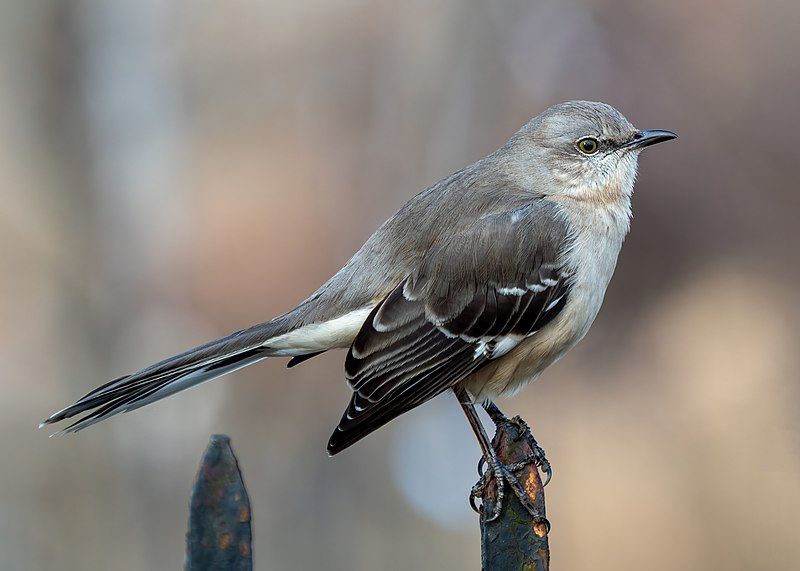
The northern mockingbird is a type of bird that is commonly found in North America. It is known for its ability to mimic the songs of other birds and even sounds from its environment.
This bird is typically seen throughout the year in North America, as it is a permanent resident in the region. However, during extreme weather, such as harsh winters, some northern mockingbirds may migrate south in search of more favorable conditions.
This migration is not shared and only occurs when the weather becomes too challenging for these birds to handle. Despite being primarily found in North America, the northern mockingbird has been occasionally observed in Europe.
However, such sightings are rare, and this species is not considered a regular visitor to the European continent. It is interesting to note the adaptability of the northern mockingbird in terms of its ability to survive in different environments.
While it is mainly found in North America, it can move to more suitable locations during adversity. The northern mockingbird’s ability to mimic sounds is a unique characteristic that sets it apart from other bird species.
This skill allows it to imitate the songs of various birds and sounds like car alarms, sirens, or even human speech.
| Kingdom | Animalia |
| Phylum | Chordata |
| Clade | Dinosauria |
| Class | Aves |
| Order | Passeriformes |
| Family | Mimidae |
| Genus | Mimus |
| Species | M. polyglottos |
3. House Sparrow
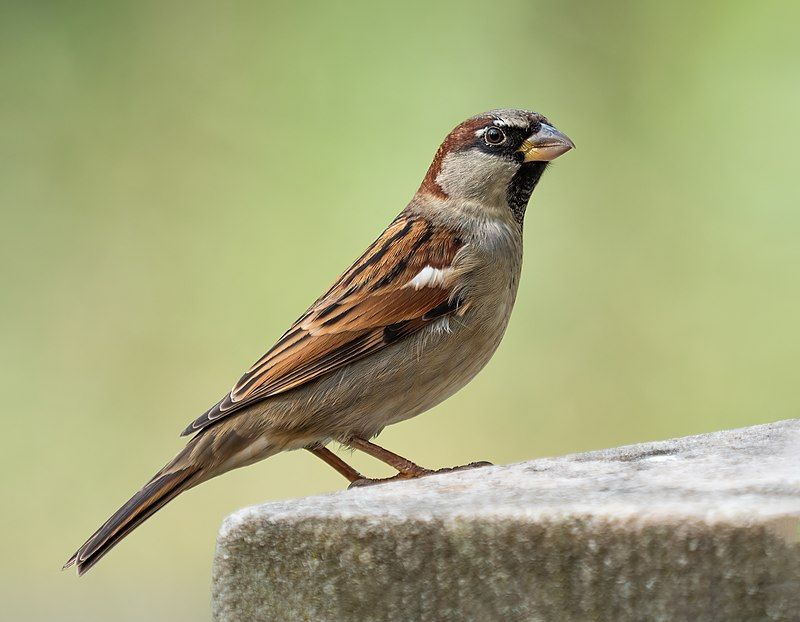
The house sparrow is a type of bird that belongs to the sparrow family called Passeridae. These birds can be found in many different parts of the world. They are pretty small, typically measuring about 16 cm in length.
In terms of weight, they usually range between 24 to 39.5 grams. Regarding their appearance, female and young house sparrows are generally colored in pale shades of brown and grey.
This coloration helps them blend in with their surroundings and provides them with some camouflage. On the other hand, male house sparrows have more vibrant colors.
They display black, white, and brown markings, making them easily distinguishable from the females and young birds.
The contrasting colors of the male house sparrows serve various purposes. Firstly, these colors help attract mates during the breeding season.
The brighter markings act as a visual signal to the females, indicating that the male is healthy and capable of providing for offspring.
These markings also play a role in defending territory and establishing dominance among other male sparrows. The house sparrow’s coloration is not only limited to their feathers. They also have distinct beak colors that differ between males and females.
| Kingdom | Animalia |
| Phylum | Chordata |
| Clade | Dinosauria |
| Class | Aves |
| Order | Passeriformes |
| Family | Passeridae |
| Genus | Passer |
| Species | P. domesticus |
4. Great Egret
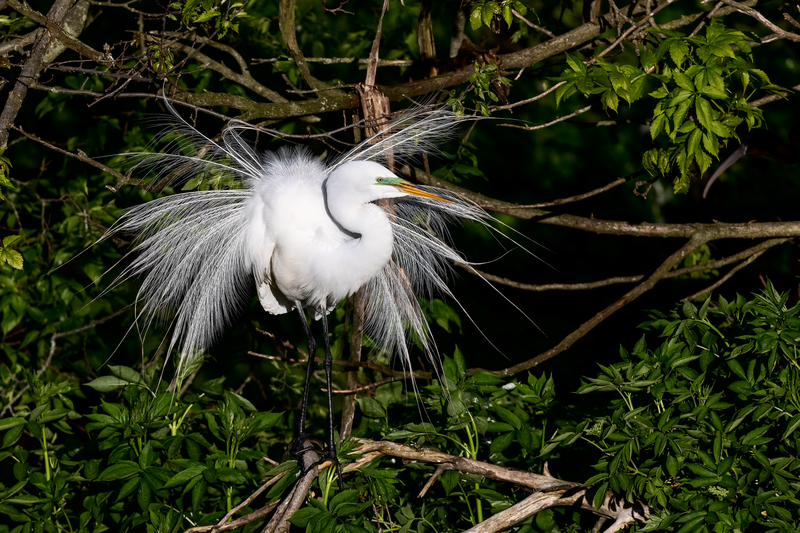
The great egret is a type of bird commonly referred to as the common egret, large egret, great white egret, or great white heron. It is known for its large size and can be found in many different parts of the world.
The great egret has four subspecies, each of which is found in different regions. One subspecies of the great egret is found in Asia. These birds can be seen in various countries across the continent.
They are known for their elegant appearance and are often found near bodies of water, such as rivers, lakes, and ponds. Another subspecies of the great egret is found in Africa.
These birds can be spotted in different habitats throughout the continent, including wetlands, marshes, and coastal areas. They are skilled hunters and feed on fish, frogs, and other small aquatic creatures. The third subspecies of the great egret is found in the Americas.
This includes both North and South America. These birds can be found in various environments, such as swamps, estuaries, and urban areas.
They are known for their graceful flight and striking white plumage. The final subspecies of the great egret is found in southern Europe.
| Kingdom | Animalia |
| Phylum | Chordata |
| Clade | Dinosauria |
| Class | Aves |
| Order | Pelecaniformes |
| Family | Ardeidae |
| Genus | Ardea |
| Species | A. alba |
5. Blue Jay
The blue jay is a bird that belongs to the family Corvidae. It can be found in eastern North America. This bird is commonly found in many eastern and central United States parts.
However, it is essential to note that some blue jays in the eastern regions may migrate to other areas. In addition to the United States, blue jays reside in Newfoundland, Canada. They are considered residents in this area.
Breeding populations of blue jays can be observed across southern Canada. This means that these birds reproduce and raise their young in this region. The blue jay is a passerine bird, meaning it has specialized feet that allow it to perch on tree branches.
It is native to eastern North America and can be found in various parts of the United States, Newfoundland, and southern Canada.
| Kingdom | Animalia |
| Phylum | Chordata |
| Clade | Dinosauria |
| Class | Aves |
| Order | Passeriformes |
| Family | Corvidae |
| Genus | Cyanocitta |
| Species | C. cristata |
6. White-Winged Dove

The white-winged dove is found in various regions, such as the Southwestern United States, Mexico, Central America, and the Caribbean. These doves are relatively giant compared to other doves.
One key feature that sets them apart from similar doves is the noticeable white edge on their wings.
This white marking is a distinguishing characteristic of the white-winged dove. In addition to the white wing edges, these doves have a unique blue eyering encircling their eyes. This eyering further contributes to their distinct appearance.
Moreover, their eyes are vibrant red, which adds to their overall attractiveness. The white-winged dove’s native habitat spans a wide geographic range, including the Southwestern United States, Mexico, Central America, and the Caribbean.
This means they are well-adapted to various climates and environments within these regions. Their ability to thrive in different locations contributes to their widespread distribution. Due to their larger size, white-winged doves often stand out among other dove species.
Their size can vary, but they are generally considered on the larger end of the dove spectrum. This physical attribute helps bird enthusiasts and researchers differentiate them.
| Kingdom | Animalia |
| Phylum | Chordata |
| Clade | Dinosauria |
| Class | Aves |
| Order | Columbiformes |
| Family | Columbidae |
| Genus | Zenaida |
| Species | Z. asiatica |
7. Carolina Chickadee
The Carolina chickadee is a type of bird that belongs to the passerine bird family known as Paridae. It is a small bird that is often seen in North America.
The passerine bird family includes other birds like tits, which are known for their small size and agile nature. Carolina chickadees are known for their distinct appearance and behavior. They have a round body shape, short necks, and trim beaks.
Their feathers are primarily gray on the upperparts and white on the underparts, with black and white markings on their wings and tails.
This coloration helps them blend in with their surroundings and provides camouflage for protection. These birds are often found in deciduous and mixed forests and residential areas with trees and shrubs.
They prefer habitats with a variety of vegetation, including both coniferous and deciduous trees.
They are also known to visit bird feeders in people’s yards, especially during winter, when food is scarce. Carolina chickadees are social birds and are often seen in small flocks.
They communicate with each other through a variety of vocalizations, including their well-known “chick-a-dee-dee-dee” call.
| Kingdom | Animalia |
| Phylum | Chordata |
| Clade | Dinosauria |
| Class | Aves |
| Order | Passeriformes |
| Family | Paridae |
| Genus | Poecile |
| Species | P. carolinensis |
8. Carolina Wren
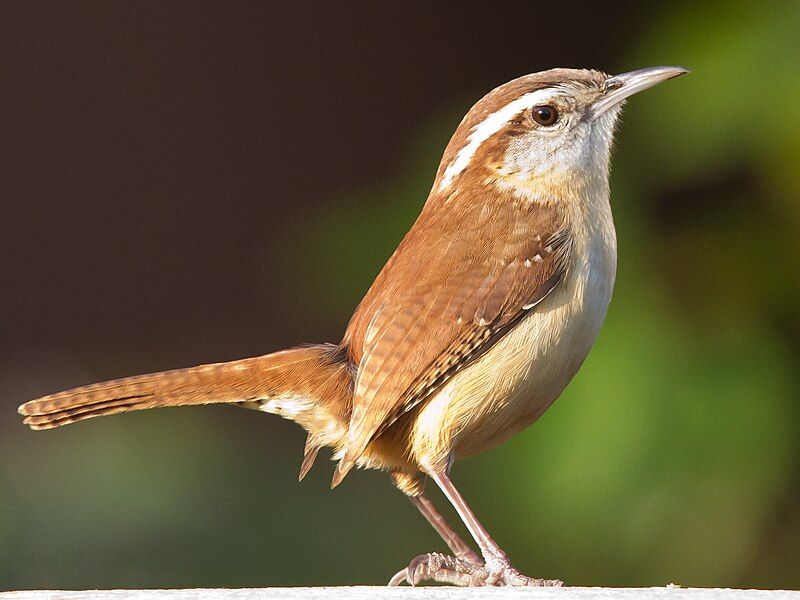
The Carolina wren is a type of wren bird found in several regions. It is considered a common species, frequently seen in these areas. The bird is mainly found in the eastern half of the United States of America.
This includes states like North Carolina, South Carolina, and Virginia. However, it can also be spotted in other states within this region. Apart from the United States, the Carolina wren is also seen in certain parts of Canada.
Specifically, it can be found in the extreme south of Ontario. This means it is only present in the southernmost part of the province.
This is interesting because the bird’s range extends beyond the borders of the United States. Additionally, the Carolina wren can be observed in the extreme northeast of Mexico.
This means it is in the country’s northeastern part, close to the border it shares with the United States.
This further highlights the bird’s ability to inhabit different regions within North America. The Carolina wren is a resident bird in the eastern half of the United States, the extreme south of Ontario, Canada, and the extreme northeast of Mexico.
It is a common species, often seen in these areas. Its range includes several states.
| Kingdom | Animalia |
| Phylum | Chordata |
| Clade | Dinosauria |
| Class | Aves |
| Order | Passeriformes |
| Family | Troglodytidae |
| Genus | Thryothorus |
| Species | T. ludovicianus |
9. Mourning Dove
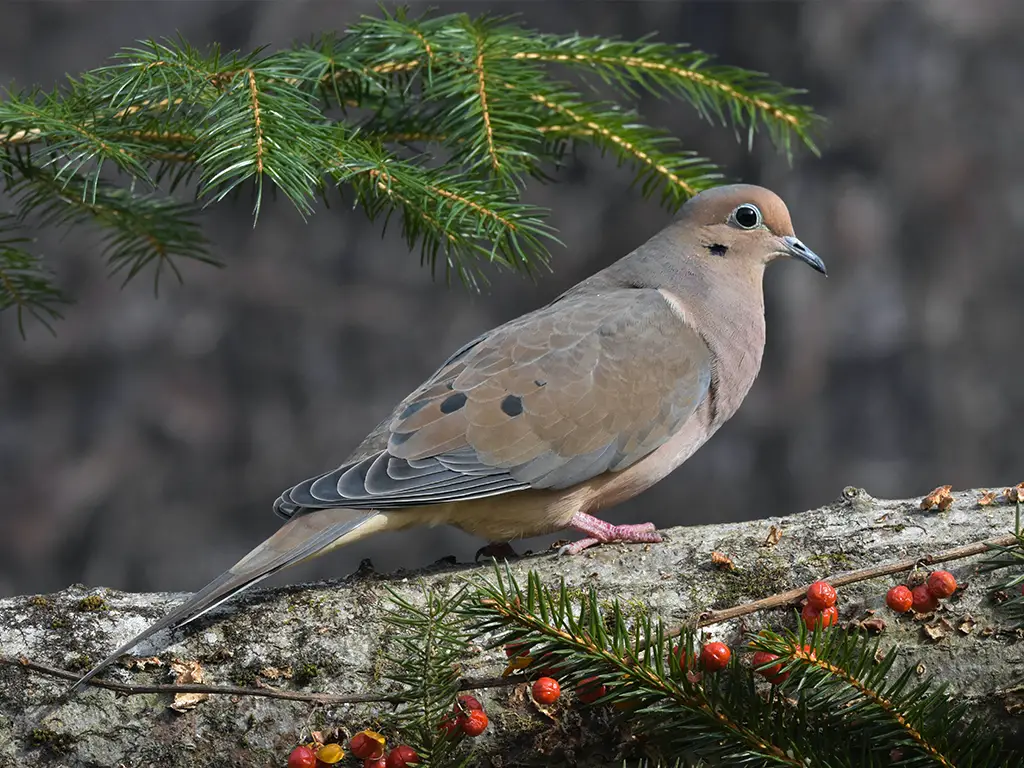
The mourning dove is a type of bird that belongs to the dove family called Columbidae. This bird is also known by different names, such as the American mourning dove, the rain dove, colloquially, and the turtle dove.
In the past, it was referred to as the Carolina pigeon and Carolina turtledove. The mourning dove is a common species found in North and Central America. It is recognized for its soft, mournful cooing sound, which gives it its name.
This bird is known for its slender body and long, pointed tail. It has a grayish-brown color with lighter shades on its underparts. One interesting fact about mourning doves is their ability to adapt to various habitats.
They can be found in different environments like forests, fields, urban areas, and deserts. They are known to thrive in both rural and suburban settings. Mourning doves primarily feed on seeds, grains, and fruits.
They have a unique diet as they can swallow seeds whole and store them in their crop, a specialized part of their digestive system. This allows them to eat in one location and then retreat to a safer place to digest their food. These birds are monogamous, meaning they mate.
| Kingdom | Animalia |
| Phylum | Chordata |
| Clade | Dinosauria |
| Class | Aves |
| Order | Columbiformes |
| Family | Columbidae |
| Genus | Zenaida |
| Species | Z. macroura |
10. Cardinalidae
Cardinalidae is a family of birds found only in the New World. This means that they are native to the Americas and are not found anywhere else in the world. The family comprises different species, including cardinals, grosbeaks, and buntings.
These birds are all part of the same family because they share similar characteristics and traits. Cardinals are perhaps the most well-known members of the Cardinalidae family. They are known for their vibrant red plumage, which is more prominent in males than females.
Cardinals often feed on seeds and insects in backyards and gardens. They have a distinct crest on their heads, which adds to their unique appearance. Grosbeaks are another type of bird that belongs to the Cardinalidae family.
They are named after their large, thick beaks, adapted for cracking open seeds and nuts. Grosbeaks come in various colors, including red, black, and yellow.
They are known for their beautiful songs and can be found in forests and woodlands across the Americas. Buntings are also part of the Cardinalidae family. They are small to medium-sized birds that are known for their colorful plumage.
| Kingdom | Animalia |
| Phylum | Chordata |
| Clade | Dinosauria |
| Class | Aves |
| Order | Passeriformes |
| Family | Cardinalidae |
11. American Goldfinch
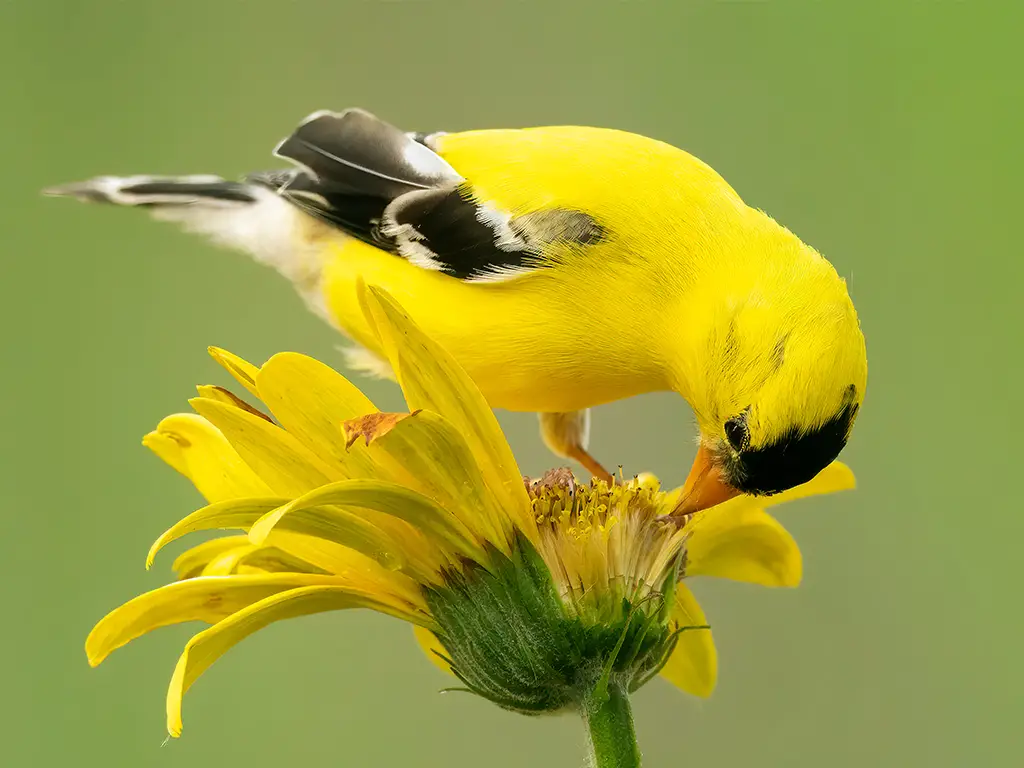
The American goldfinch is a type of bird found in North America.
It belongs to the finch family, a group of small birds known for their colorful feathers and pleasant songs. This bird is migratory, meaning it travels from one place to another depending on the time of year.
When they mate and lay eggs during the breeding season, the American goldfinch can be found in areas ranging from mid-Alberta in Canada to North Carolina in the United States. When the weather gets colder in the winter, the American goldfinch migrates to a different region.
They move from just south of the Canada–United States border and travel down to Mexico.
This helps them find better conditions for survival as the temperature and food availability change with the seasons. The reason for their migration is mainly related to the availability of food.
During the breeding season, the American goldfinch feeds on insects and seeds from plants like sunflowers and thistles.
These food sources are abundant in the areas where they breed, providing them with the necessary nutrients for reproduction and raising their young. However, these insects and plants may not be readily available in their breeding grounds during the winter.
| Kingdom | Animalia |
| Phylum | Chordata |
| Clade | Dinosauria |
| Class | Aves |
| Order | Passeriformes |
| Family | Fringillidae |
| Genus | Spinus |
| Species | S. tristis |
12. Downy Woodpecker
The downy woodpecker is a type of bird known as a woodpecker. It is the smallest species of woodpecker found in North America. Its size can range from 14 to 18 centimeters.
These woodpeckers can be found in various forested areas across the United States and Canada.
However, they are not commonly seen in desert regions in the southwest or the northern tundra. Due to their small size, downy woodpeckers are well-adapted to living in forested environments.
They can navigate through the trees and search for food more quickly than larger woodpecker species. One exciting feature of the downy woodpecker is its ability to drum on trees.
This drumming serves multiple purposes, including communication with other woodpeckers and marking its territory. The diet of the downy woodpecker primarily consists of insects and larvae found within the trees.
They use their strong beaks to peck at the bark and wood, uncovering their prey. These woodpeckers are known for their distinct black and white plumage. They have a white belly and back, with black wings and a black head. This coloration helps them blend in with the tree.
| Kingdom | Animalia |
| Phylum | Chordata |
| Clade | Dinosauria |
| Class | Aves |
| Order | Piciformes |
| Family | Picidae |
| Genus | Dryobates |
| Species | D. pubescens |
13. Red-Bellied Woodpecker
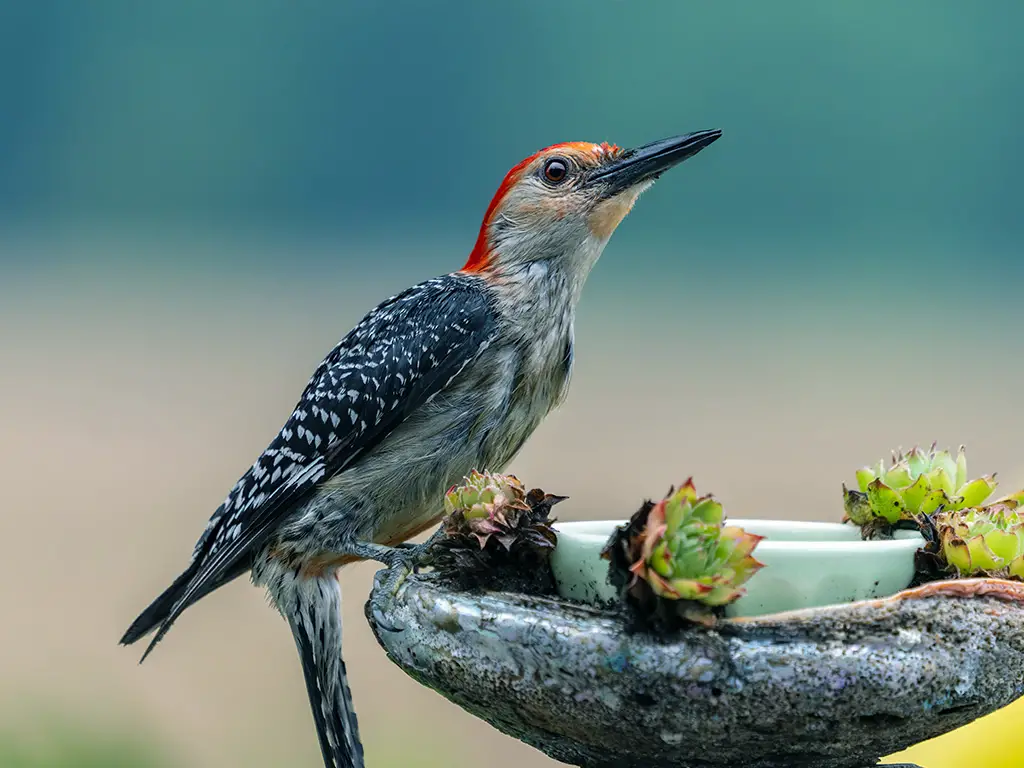
The red-bellied woodpecker is a bird that belongs to the family Picidae. It is not too big or small; it is considered a medium-sized woodpecker.
This means it is smaller than other woodpecker species but more significant than others. These woodpeckers are found primarily in the eastern part of the United States. However, they can also be seen in other areas.
They have a wide range, stretching from as far south as Florida to as far north as Canada. This means that they can be found in many different states and provinces within these regions. Regarding their appearance, the red-bellied woodpecker has some distinct features.
As the name suggests, they have a red belly, although this may not be immediately noticeable. Their belly is more of a pale or dull red color compared to other parts of their body.
They also have a red cap on the top of their head, which is more vibrant and noticeable. In addition to their red belly and cap, these woodpeckers have a black and white pattern on their back, wings, and tail.
The black feathers provide a nice contrast against the white feathers, creating a visual.
| Kingdom | Animalia |
| Phylum | Chordata |
| Clade | Dinosauria |
| Class | Aves |
| Order | Piciformes |
| Family | Picidae |
| Genus | Melanerpes |
| Species | M. carolinus |
14. Ruby-Crowned Kinglet
The ruby-crowned kinglet is a small bird found all over North America. It belongs to the kinglet family, which includes other small bird species. This bird has olive-green feathers that cover its body.
Additionally, it has two white bars on its wings and a white ring around its eye. If we look closely, we can notice some differences between males and females of the species. The male ruby-crowned kinglet has a unique feature on its head – a red patch on its crown.
However, this patch is not always visible as it is often hidden. On the other hand, female ruby-crowned kinglets do not have this red crown patch. Despite their small size, these birds are known for their energetic and active behavior.
They are constantly flying and hopping from branch to branch for food. Ruby-crowned kinglets feed on insects, spiders, and small invertebrates in trees and shrubs. One interesting fact about these birds is that they are known to be quite vocal.
They produce a variety of sounds to communicate with each other. Their songs consist of high-pitched and rapid notes, which can be quite melodic and pleasant to hear. During the breeding season, males ruby-crowned.
| Kingdom | Animalia |
| Phylum | Chordata |
| Clade | Dinosauria |
| Class | Aves |
| Order | Passeriformes |
| Family | Regulidae |
| Genus | Corthylio |
| Species | C. calendula |
15. Orange-Crowned Warbler

The orange-crowned warbler is a type of bird. It belongs to the New World warbler family, a group of songbirds in the Americas.
This particular warbler is small, making it relatively tiny compared to other bird species. As a New World warbler family member, the orange-crowned warbler shares specific characteristics with its relatives.
These birds are known for their beautiful songs, which they use to communicate and attract mates.
The warbler’s melodious voice is often heard during the breeding season when male birds sing to establish their territory and woo females. The orange-crowned warbler gets its name from a distinct feature – its orange crown.
This small bird has a patch of bright orange feathers on the top of its head, which helps to identify it.
However, this orange crown is not always visible, as it can be flattened or hidden under the bird’s brownish-greenish plumage. Like many other singers, the orange-crowned warbler is migratory. This means it travels long distances between its breeding grounds and wintering areas.
During the breeding season, these warblers can be found in parts of North America, including Canada and the United States, however, when winter arrives.
| Kingdom | Animalia |
| Phylum | Chordata |
| Clade | Dinosauria |
| Class | Aves |
| Order | Passeriformes |
| Family | Parulidae |
| Genus | Leiothlypis |
| Species | L. celata |
16. Red-Tailed Hawk
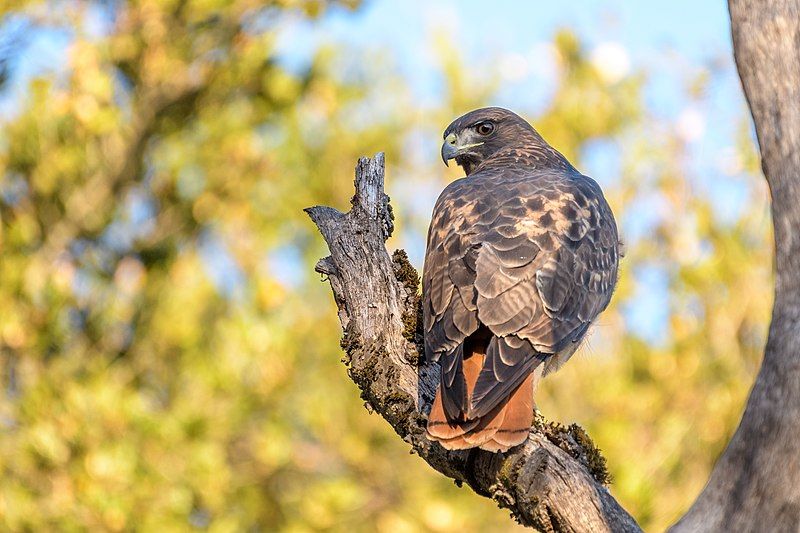
The red-tailed hawk is a type of bird known as a bird of prey. It is found in many different parts of North America. It breeds in various locations, from the interior of Alaska and northern Canada to Panama and the West Indies.
This means you can find red-tailed hawks in many places throughout North America. The red-tailed hawk belongs to a group of birds called the genus Buteo. This genus includes many other species of hawks.
However, the red-tailed hawk is one of the most common members of this group, both in North America and worldwide.
You will likely encounter a red-tailed hawk more often than others within the Buteo genus. The red-tailed hawk is known for its distinctive red tail, which is where it gets its name from.
This feature helps to distinguish it from other types of hawks. However, it is essential to note that not all red-tailed hawks have red tails.
Juvenile red-tailed hawks have brown tails, which only turn red as they mature. Red-tailed hawks are known for their impressive hunting skills. As birds of prey, they primarily.
| Kingdom | Animalia |
| Phylum | Chordata |
| Clade | Dinosauria |
| Class | Aves |
| Order | Accipitriformes |
| Family | Accipitridae |
| Genus | Buteo |
| Species | B. jamaicensis |
17. Yellow-Rumped Warbler
The yellow-rumped warbler is a type of bird found in North America. It is pretty standard and can be seen everywhere across the continent. This bird species is known for its distinct yellow feathers on its rump or lower back.
This is where it gets its name from. These yellow feathers make it easy to identify the yellow-rumped warbler in the wild. The yellow-rumped warbler is a small bird, measuring around 5 to 6 inches in length. It has a slim body with a pointed beak and long wings.
Its wingspan can reach 9 to 10 inches, allowing it to fly swiftly and gracefully. One interesting fact about this bird is that it is known for its ability to migrate long distances. Yellow-rumped warblers can be found in North America during the breeding season.
However, they migrate south to warmer regions, such as Mexico and Central America, when winter arrives. This bird species can be found in a variety of habitats. It is often seen in forests, woodlands, and even urban areas.
It has adapted well to different environments and can thrive in deciduous and coniferous forests. The yellow-rumped warbler has a diverse.
| Kingdom | Animalia |
| Phylum | Chordata |
| Clade | Dinosauria |
| Class | Aves |
| Order | Passeriformes |
| Family | Parulidae |
| Genus | Setophaga |
| Species | S. coronata |
18. Common Starling
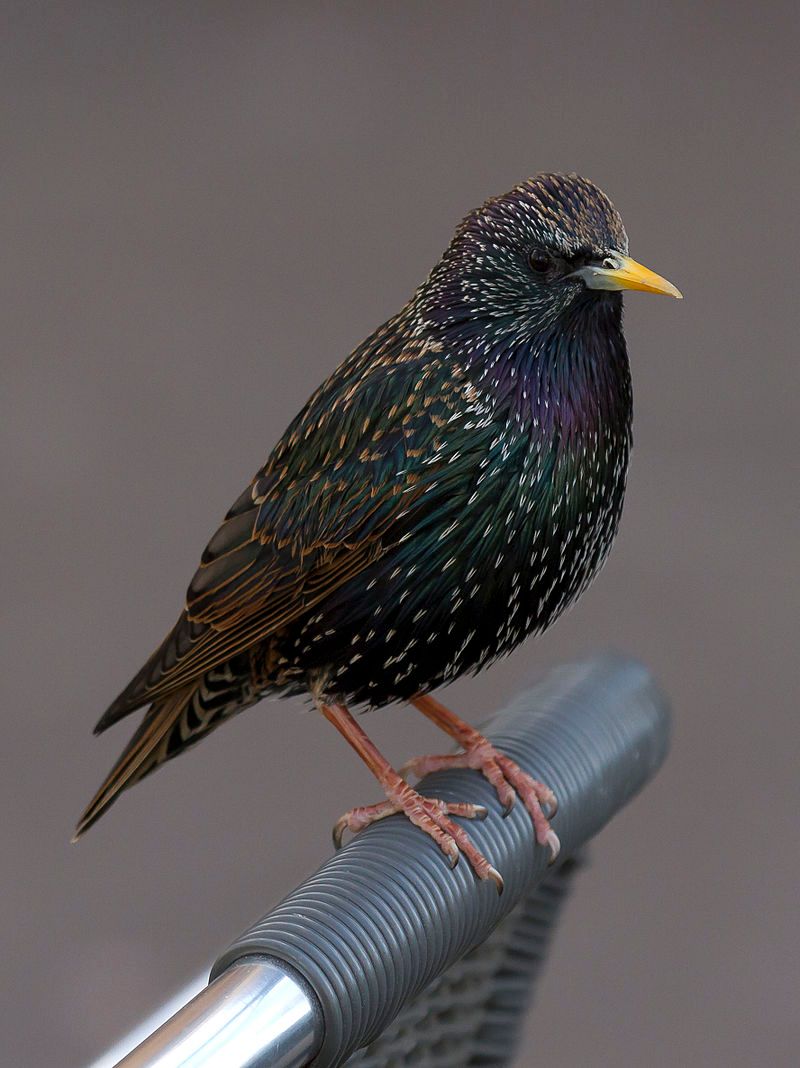
The common starling is a type of bird found in various regions. Depending on the location, it is referred to by different names. It is known as the European starling in North America, while it is called the starling in Great Britain and Ireland.
This bird belongs to the starling family, scientifically known as Sturnidae. The common starling is classified as a passerine bird with a medium-sized build. Passerine birds are characterized by having feet adapted for perching, and they make up the most significant order of birds.
The starling family, to which the common starling belongs, is known for its diverse species worldwide. The common starling is known for its unique features and behaviors. It has a sleek and shiny black plumage with speckled spots, which gives it a distinct appearance.
The bird’s feathers can also appear iridescent in certain lighting conditions, showcasing shades of green and purple. One of the remarkable aspects of the common starling is its ability to mimic sounds and voices.
It has various vocalizations and can imitate multiple sounds in its environment, including other bird calls, human speech, and even mechanical noises.
| Kingdom | Animalia |
| Phylum | Chordata |
| Clade | Dinosauria |
| Class | Aves |
| Order | Passeriformes |
| Family | Sturnidae |
| Genus | Sturnus |
| Species | S. vulgaris |
19. American Crow
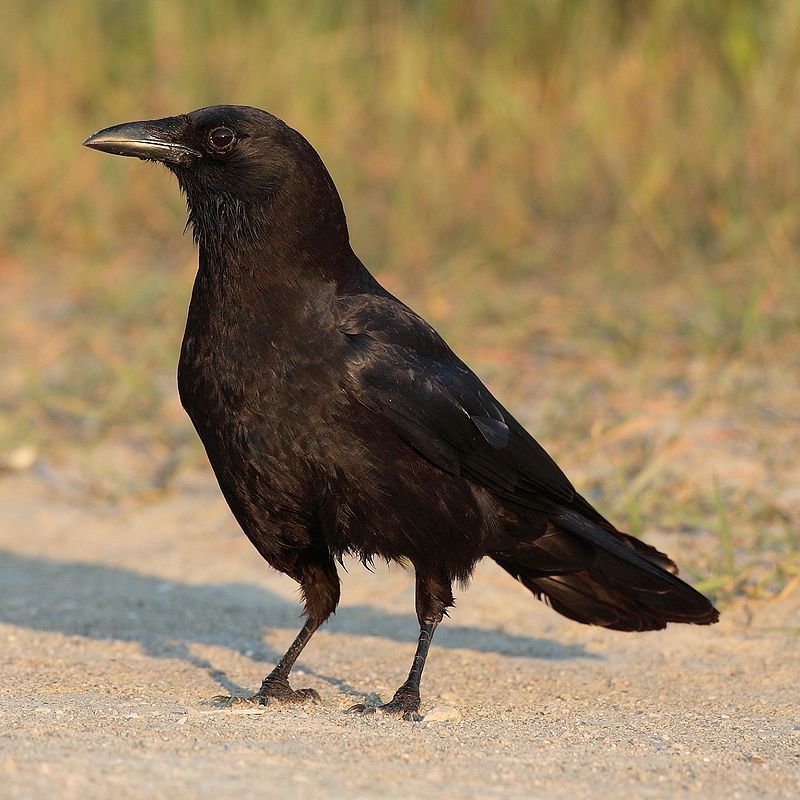
The American crow is a type of bird that belongs to the Corvidae family. This family includes other birds like ravens and jays. The American crow is extensive and known as a passerine bird, meaning it has feet adapted for perching on branches.
You can find American crows in many parts of North America. They are widespread birds, so you might have seen them in your neighborhood. They have adapted well to different environments and can be found in urban areas, forests, and open fields.
Interestingly, American crows are similar to two other crows in different parts of the world. These are the carrion crow and the hooded crow found in Europe and Asia.
Despite being from different continents, these three crows occupy the same ecological niche. An ecological niche refers to the role a species plays in its environment. In this case, the American crow, carrion crow, and hooded crow have similar behaviors and habits.
They are opportunistic feeders, meaning they eat a wide range of things like insects, fruits, small animals, and even garbage. They also play essential roles in controlling populations of certain pests and scavenging.
| Kingdom | Animalia |
| Phylum | Chordata |
| Clade | Dinosauria |
| Class | Aves |
| Order | Passeriformes |
| Family | Corvidae |
| Genus | Corvus |
| Species | C. brachyrhynchos |
20. Red-Winged Blackbird
The red-winged blackbird is a type of bird that belongs to the passerine family called Icteridae.
It is commonly found in various parts of North America and a significant portion of Central America. Passerines are a diverse group of birds known for their musical and complex songs.
They have specialized vocal organs that produce a wide range of sounds. The red-winged blackbird is easily recognizable due to its distinct appearance.
The male red-winged blackbird has glossy black plumage and bright red patches on its wings, which give it its name.
On the other hand, the female red-winged blackbird has a more subdued appearance with brown feathers and streaks. These birds have a unique habitat preference, as they are commonly found in wetlands, marshes, and areas with tall grasses.
They are skilled at perching on tall plants and reeds, where they can easily spot their prey and potential predators. Red-winged blackbirds primarily feed on insects, seeds, and grains. They use their sharp beaks to catch insects on the fly and extract seeds from plants.
During the breeding season, they may consume small vertebrates such as frogs and tadpoles.
| Kingdom | Animalia |
| Phylum | Chordata |
| Clade | Dinosauria |
| Class | Aves |
| Order | Passeriformes |
| Family | Icteridae |
| Genus | Agelaius |
| Species | A. phoeniceus |
21. Eastern Phoebe
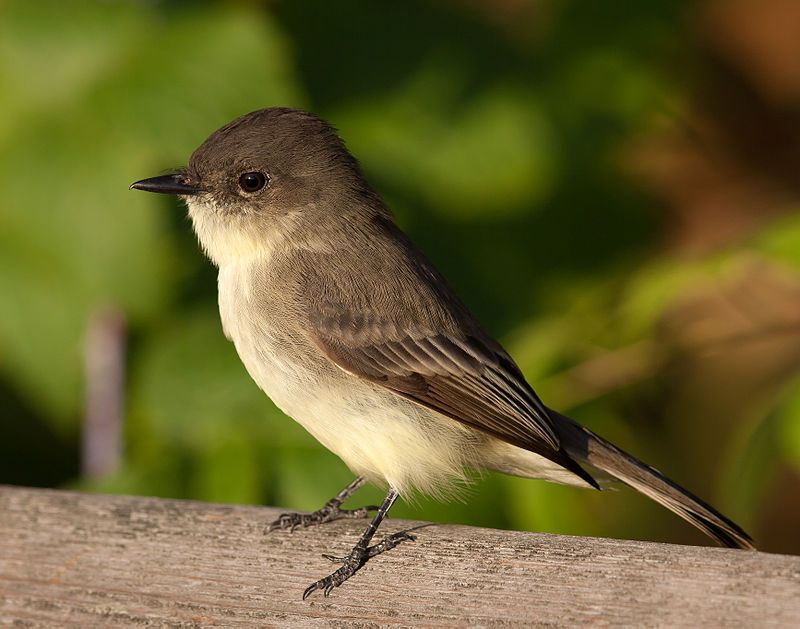
The eastern phoebe is a small bird that belongs to the passerine family. This family includes birds with feet specially adapted for perching, singing, and eating seeds or insects.
The eastern phoebe is one of these birds. The scientific name of the east phoebe is Sayornis. This name is derived from the specific part of Charles Lucien Bonaparte’s name for Say’s phoebe, another closely related bird species.
Charles Lucien Bonaparte, a French ornithologist, discovered and named several bird species. The specific name for Say’s phoebe, Muscicapa saya, was taken by Bonaparte and combined with the Ancient Greek word “ornis,” which means “bird.”
This combination resulted in the genus name Sayornis for the eastern phoebe. The genus name is essential in scientific classification because it helps scientists categorize and identify different species.
Using a standardized naming system, scientists can communicate more effectively about specific birds and their characteristics. In this case, the genus name Sayornis indicates that the eastern phoebe is closely related to Say’s phoebe.
It helps scientists understand the evolutionary relationships between these two species.
| Kingdom | Animalia |
| Phylum | Chordata |
| Clade | Dinosauria |
| Class | Aves |
| Order | Passeriformes |
| Family | Tyrannidae |
| Genus | Sayornis |
| Species | S. phoebe |
22. Turkey Vulture
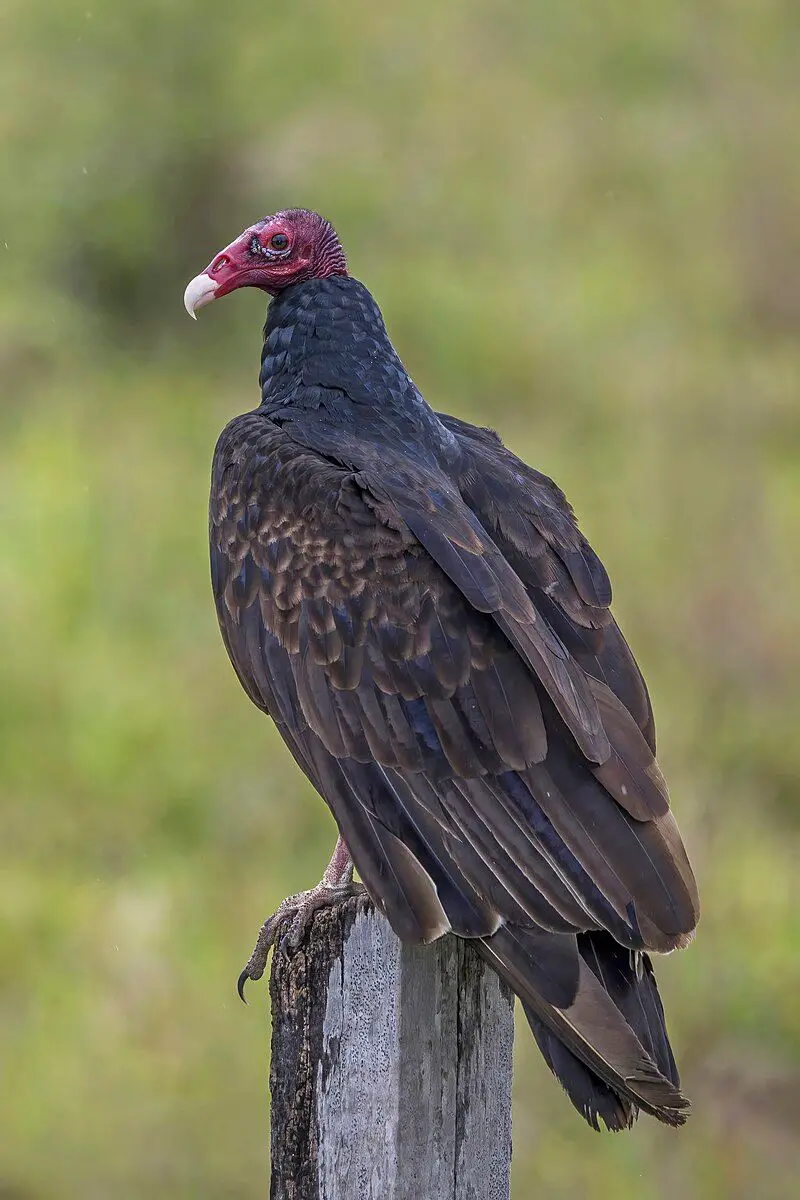
The turkey vulture is a type of vulture found in many different parts of the Americas. It is the most widespread of all the New World vultures. There are three species of vultures in a group called the genus Cathartes.
The turkey vulture is one of these species. It belongs to the family Cathartidae, a bird group that includes vultures. The turkey vulture can be found in a vast range of locations.
It can be seen from southern Canada down to the very tip of South America. This means it can be found in many different American countries and environments. This bird has an extensive range because it is well-adapted to various habitats.
It can thrive in a wide range of conditions and climates. The turkey vulture is known for its characteristic appearance. It has a bald head, which is red. Its body is black or dark brown, with long wings and a long tail.
This vulture is a scavenger, meaning it feeds on dead animals. It has a highly developed sense of smell, which allows it to locate carrion from high.
| Kingdom | Animalia |
| Phylum | Chordata |
| Clade | Dinosauria |
| Class | Aves |
| Order | Accipitriformes |
| Family | Cathartidae |
| Genus | Cathartes |
| Species | C. aura |
23. American Kestrel
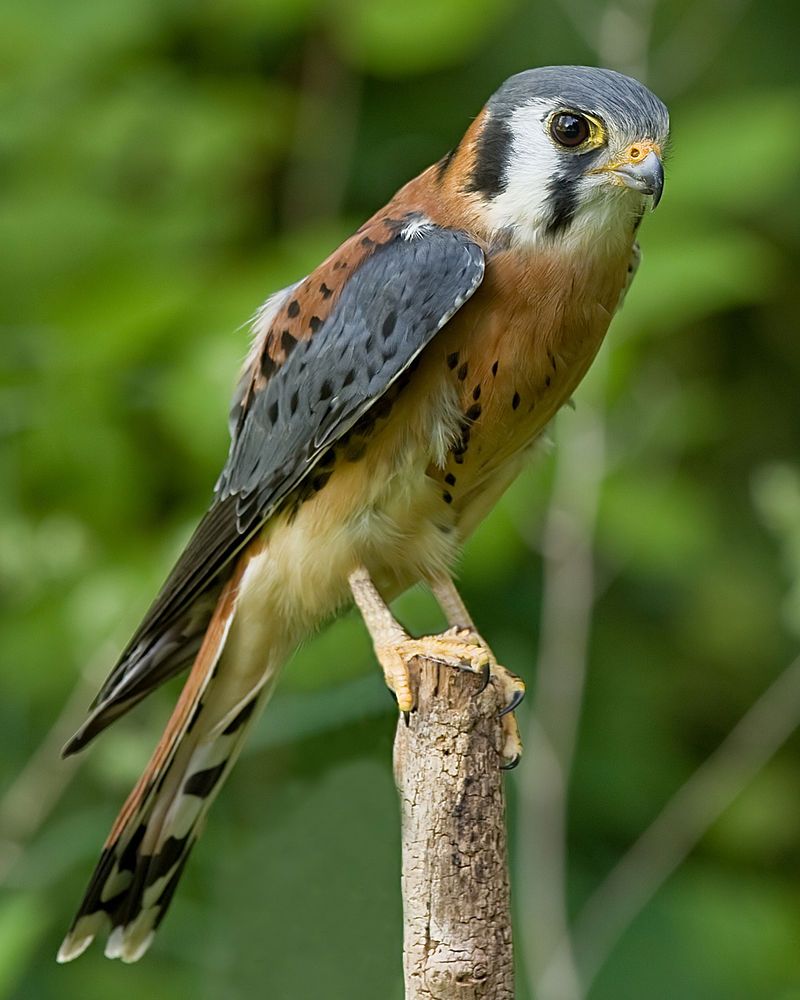
The American kestrel is a type of falcon that can also be known as the sparrow hawk. It is found in North America and is the region’s smallest and most common falcon. The size of the American kestrel can vary depending on the subspecies and the sex of the bird.
Generally, there is a two-to-one range in size between different individuals. When it comes to size, the American kestrel can range from being as small as a blue jay to as large as a mourning dove.
This means some individuals can weigh as much as a blue jay, while others can be as heavy as a mourning dove. The variation in size within the American kestrel population can be attributed to differences in subspecies and between males and females.
This means that females may generally be more significant than males, and different subspecies may have different average sizes. Interestingly, despite this size variation, the American kestrel remains the smallest falcon in North America.
This indicates that even the most prominent individuals of this species are still relatively small compared to other falcons in the region. In conclusion, the American kestrel is also known as the sparrow.
| Kingdom | Animalia |
| Phylum | Chordata |
| Clade | Dinosauria |
| Class | Aves |
| Order | Falconiformes |
| Family | Falconidae |
| Genus | Falco |
| Species | F. sparverius |
24. Great Blue Heron
The great blue heron is a bird from the heron family called Ardeidae. It is a big bird that is often seen wading in water. You can find it near the shores of open water and in wetlands in many parts of North and Central America.
It is also found in far northwestern South America, the Caribbean, and even the Galápagos Islands. These herons are known for their tall and slender bodies, long legs, and a long neck.
They have a distinctive blue-gray coloration on their feathers, which gives them their name.
They also have a large, dagger-like beak to catch their prey. You can often spot great blue herons standing still in shallow water, patiently waiting for fish or other small animals to come by.
They are excellent hunters and have sharp eyesight, which helps them spot their prey from a distance.
Once they see a potential meal, they use their long necks to strike quickly and snatch it up with their beaks. While they primarily feed on fish, these herons are also known to eat amphibians, reptiles, and even small mammals.
Their diet depends on what is available in their habitat. They are adaptable.
| Kingdom | Animalia |
| Phylum | Chordata |
| Clade | Dinosauria |
| Class | Aves |
| Order | Pelecaniformes |
| Family | Ardeidae |
| Genus | Ardea |
| Species | A. herodias |
25. Double-Crested Cormorant
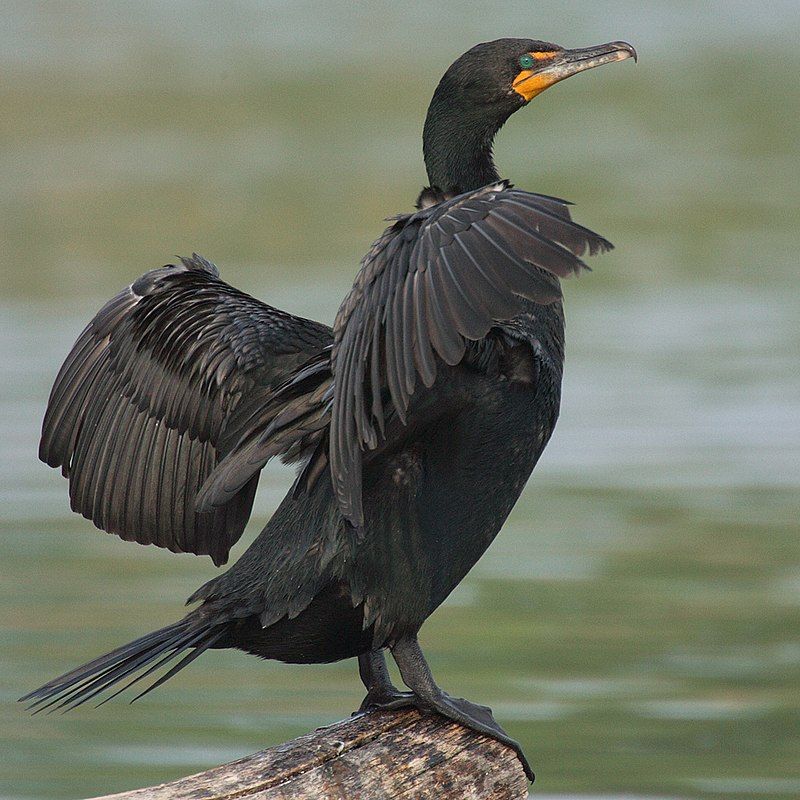
The double-crested cormorant is a type of bird that belongs to the cormorant family. It can be commonly seen near bodies of water such as rivers and lakes. You can also find this bird in coastal areas.
It is not limited to just one region, as it is widely distributed across North America. These birds can be found in various locations throughout North America. They can be seen in different habitats, from the Aleutian Islands in Alaska to Florida and Mexico.
This means that they have adapted to survive in a wide range of environments. Being part of the cormorant family, the double-crested cormorant shares specific characteristics with other birds in the same family.
They have long necks and bodies, ideal for swimming and diving in water. Their webbed feet help them paddle through the water quickly. Due to their ability to swim and dive, the double-crested cormorant can catch fish as their primary food source.
They are excellent underwater hunters, using their sharp beaks to snatch fish from the water. These birds have a unique feature – they have bright blue eyes with two tufts of feathers above them, which give them.
| Kingdom | Animalia |
| Phylum | Chordata |
| Clade | Dinosauria |
| Class | Aves |
| Order | Suliformes |
| Family | Phalacrocoracidae |
| Genus | Nannopterum |
| Species | N. auritum |
26. American Coot
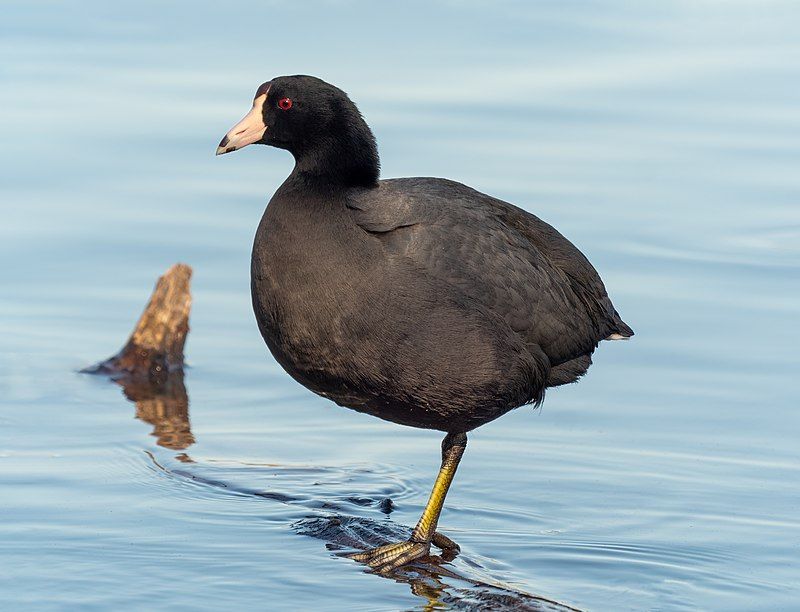
The American coot is a bird that is often confused with ducks. However, it belongs to a different family called Rallidae. This means that coots and ducks are not closely related despite some similarities. Coots are sometimes referred to as mud hens or rouleau.
These names highlight their preference for watery habitats, such as marshes, ponds, and lakeshores. They are well-adapted to living in these environments. Unlike ducks, coots have a distinct body shape. They have a plump body, short tail, and a chicken-like beak.
This unique appearance helps to differentiate them from ducks. Regarding their behavior, coots are known for their strong swimming abilities. They have lobed toes, which are not webbed like ducks but have flaps of skin that aid in propulsion through the water.
This allows them to navigate through the water with ease. Another interesting fact about coots is that they are primarily herbivorous. They feed on aquatic plants, algae, and sometimes even insects.
Their diet is well-suited to their habitat, as they can often find abundant plant material in the shallow waters they inhabit. Coots are high.
| Kingdom | Animalia |
| Phylum | Chordata |
| Clade | Dinosauria |
| Class | Aves |
| Order | Gruiformes |
| Family | Rallidae |
| Genus | Fulica |
| Species | F. americana |
27. Osprey
The osprey is a bird known by different names, such as sea hawk, river hawk, and fish hawk. It is a bird of prey that hunts and eats fish and is active during the daytime, which means it is diurnal.
The osprey can be found in various parts of the world, as it has a cosmopolitan range. In terms of size, the osprey is considered to be a large bird. It can grow to be more than 60 cm long, and its wingspan can reach 180 cm.
This makes it impressive when it takes flight and soars through the sky. In terms of appearance, the osprey has distinct coloring. The upper parts of its body are brown, which helps it blend in with its surroundings when perched on trees or other structures.
However, its head and underparts are predominantly greyish. This coloring may provide camouflage when the osprey is near bodies of water, where it hunts for fish. Overall, the osprey is a fascinating bird with unique characteristics.
Its ability to hunt fish, its large size, and its distinct coloring make it a remarkable species to observe in its natural habitat.
| Kingdom | Animalia |
| Phylum | Chordata |
| Clade | Dinosauria |
| Class | Aves |
| Order | Accipitriformes |
| Family | Pandionidae |
| Genus | Pandion |
| Species | P. haliaetus |
28. Tufted Titmouse

The tufted titmouse is a little bird found in North America. It belongs to the tit and chickadee family, which means it is closely related to other birds in that family.
In the past, another bird called the black-crested titmouse was thought to be a subspecies of the tufted titmouse. This means they were very similar in appearance and behavior but slightly different.
However, scientists have determined that the black-crested titmouse is a separate species. It is officially called Baeolophus atricristatus. The black-crested titmouse is found in central and southern Texas, extending southward.
This means it can also be seen in areas further south from Texas. This separation of the black-crested titmouse from the tufted titmouse is essential in the scientific world.
It helps us understand the diversity of bird species and how they are related to each other. Learning about these small songbirds and the distinctions between different species is fascinating.
Scientists can gain valuable insights into the natural world and the incredible by studying and understanding these differences.
| Kingdom | Animalia |
| Phylum | Chordata |
| Clade | Dinosauria |
| Class | Aves |
| Order | Passeriformes |
| Family | Paridae |
| Genus | Baeolophus |
| Species | B. bicolor |
29. Sharp-Shinned Hawk
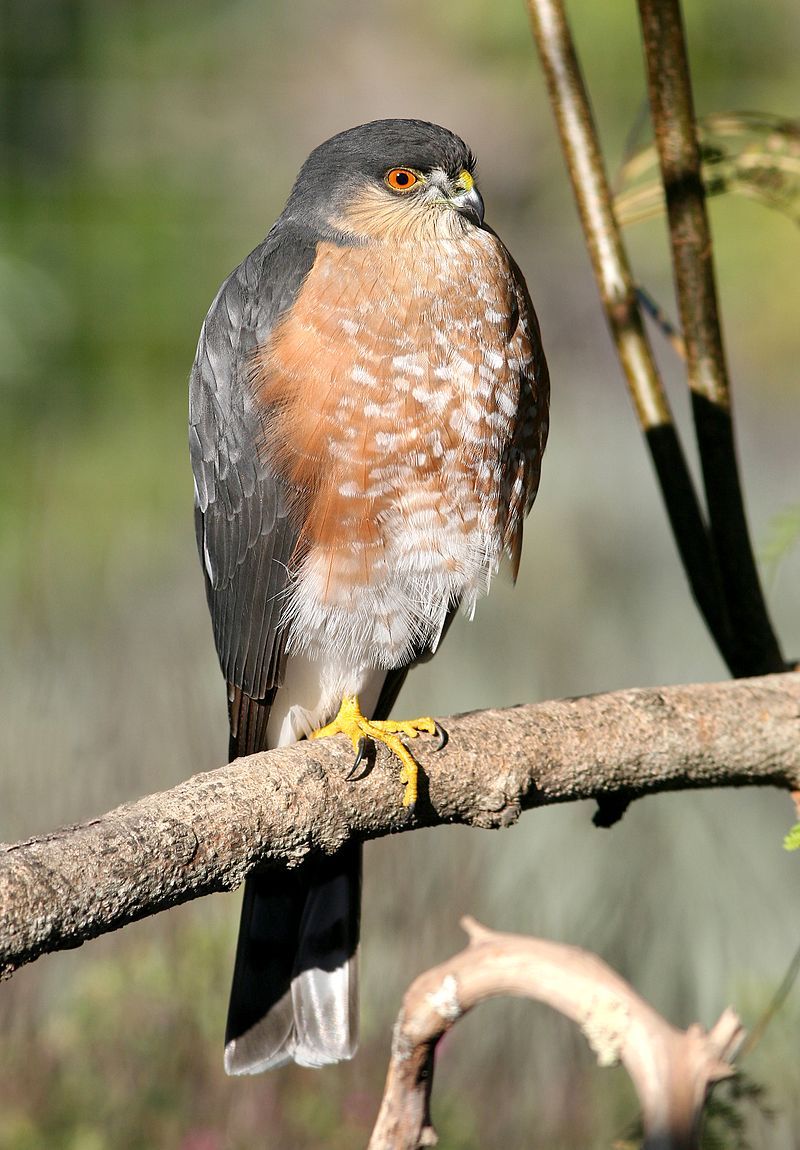
The sharp-shinned hawk, also known as a sharpie, is a small hawk type. The males of this species are the smallest hawks found in both the United States and Canada.
However, it’s worth noting that the sharp-shinned hawk is still larger than certain Neotropical species, such as the tiny hawk. This particular species of hawk is commonly referred to as a sharpie due to its sharp features and small size.
Although it is small compared to other hawks, it is essential to understand that it is still larger than certain types of hawks found in the Neotropics, a region of the Americas encompassing Central and South America.
The sharp-shinned hawk’s size is noteworthy because it is the smallest species in the United States and Canada.
This means that the sharp-shinned hawk stands out for its diminutive size compared to other hawks that inhabit these regions.
Furthermore, it is interesting to consider that despite being small in North American hawks, the sharp-shinned hawk is still more prominent on average than some Neotropical species, such as the tiny hawk.
This suggests that while the sharp-shinned hawk may be a minor relative.
| Kingdom | Animalia |
| Phylum | Chordata |
| Clade | Dinosauria |
| Class | Aves |
| Order | Accipitriformes |
| Family | Accipitridae |
| Genus | Accipiter |
| Species | A. striatus |
30. Bald Eagle
The bald eagle is a type of bird that lives in North America. It is considered a bird of prey, which means it hunts and feeds on other animals. This majestic bird is also known as a sea eagle. There are two known subspecies of the bald eagle.
Subspecies are variations of a species that have slightly different characteristics but can still interbreed. These subspecies of the bald eagle might have some differences in appearance or behavior. The bald eagle is closely related to another bird called the white-tailed eagle.
These two birds form a species pair, which means they are similar and occupy similar ecological niches.
The white-tailed eagle is found in the Palearctic region, which includes Europe, Asia, and Africa. Occupying the same niche means that the bald and white-tailed eagles have similar roles in their respective ecosystems.
They both have adaptations that help them survive and thrive in their environments.
They might compete for similar food sources or have similar hunting strategies. In the Palearctic region, where the white-tailed eagle is found, it fulfills an ecological role similar to that of the bald eagle in North America.
This means both species have evolved to fill their habitats’ specific niche or role.
| Kingdom | Animalia |
| Phylum | Chordata |
| Clade | Dinosauria |
| Class | Aves |
| Order | Accipitriformes |
| Family | Accipitridae |
| Genus | Haliaeetus |
| Species | H. leucocephalus |
31. Rough-Legged Buzzard
The rough-legged buzzard, also known as the rough-legged hawk, is a bird of prey that is medium-large in size. It can be found in the Arctic and Subarctic regions of North America, Europe, and Russia. During the breeding season, these buzzards make their home in these regions.
However, when winter arrives, they migrate south. These birds are well-suited to survive in the harsh Arctic and Subarctic climates. They have adapted to the cold weather and snowy landscapes of these regions.
The rough-legged buzzard has several physical characteristics that help it thrive in these environments. One of the distinctive features of the rough-legged buzzard is its feathered legs.
These feathers extend down to its feet, providing insulation against the cold temperatures.
This adaptation allows the bird to maintain its body heat and prevents frostbite. The rough-legged buzzard also has a large wingspan, which helps it soar through the air effortlessly. This enables the bird to cover long distances during migration and efficiently search for prey.
Their broad and rounded wings make them well-suited for gliding and hovering. Regarding hunting, the rough-legged buzzard primarily feeds on small mammals, such as rodents.
| Kingdom | Animalia |
| Phylum | Chordata |
| Clade | Dinosauria |
| Class | Aves |
| Order | Accipitriformes |
| Family | Accipitridae |
| Genus | Buteo |
| Species | B. lagopus |
32. House Finch
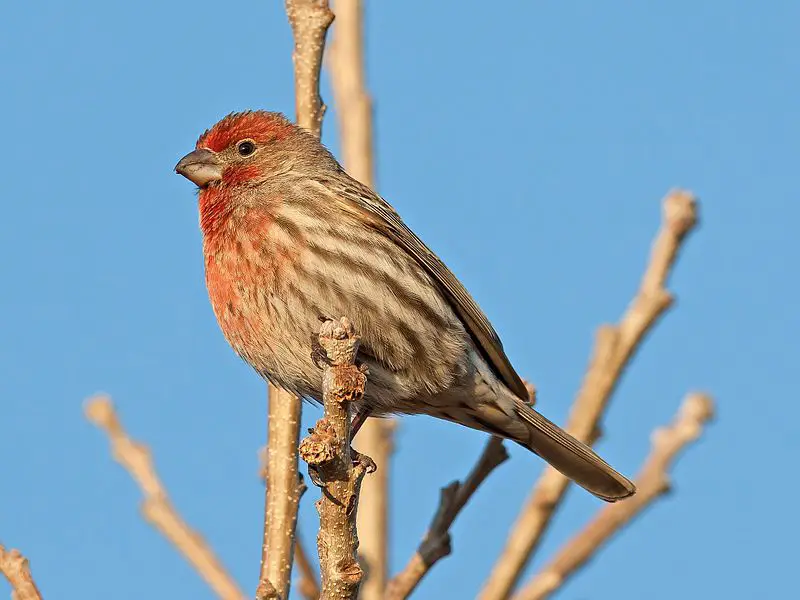
The house finch is a type of bird that belongs to the finch family called Fringillidae. This bird is originally from western North America.
However, it has also been introduced to other parts of the continent, such as the eastern half and Hawaii. The house finch is not the only bird in its genus.
It is grouped with two other American rosefinches, and all three are placed in the genus Haemorhous. The house finch is known for its beautiful red coloration, especially in males. The males have a reddish hue on their heads, chests, and backs.
Females, on the other hand, have more muted colors with brownish feathers. These birds are relatively small, measuring about 12 to 16 centimeters in length. They have short wings and a slightly notched tail.
Their beaks are conical in shape and designed for cracking open seeds, their primary food source. House finches are highly adaptable and can be found in various habitats, including urban areas, forests, and grasslands.
They are known for their melodic songs, which they use to communicate and attract mates. Breeding season for these.
| Kingdom | Animalia |
| Phylum | Chordata |
| Clade | Dinosauria |
| Class | Aves |
| Order | Passeriformes |
| Family | Fringillidae |
| Genus | Haemorhous |
| Species | H. mexicanus |
33. Black Skimmer
The black skimmer is a bird that resembles a tern and belongs to the skimmer genus Rynchops in the gull family Laridae. This means it shares similarities with terns and is part of a group of gulls-related birds.
One interesting fact about the black skimmer is its unique appearance. It has a predominantly black body, hence its name, with a white belly.
This coloration helps it blend in with its surroundings and makes it easier for it to catch prey. Speaking of prey, the black skimmer is a specialized bird for feeding. It has a long, thin bill lower than its upper bill.
This adaptation allows the black skimmer to skim the water’s surface while flying, catching small fish and other aquatic creatures.
It is fascinating how this bird has evolved to have such a specialized feeding technique. The black skimmer is not found all over the world. It mainly breeds in North and South America.
This means you must visit these regions if you want to observe this bird in its natural habitat. The fact that it is limited to certain areas adds to the uniqueness and importance of conserving its habitat. Conservation is a crucial aspect when.
| Kingdom | Animalia |
| Phylum | Chordata |
| Clade | Dinosauria |
| Class | Aves |
| Order | Charadriiformes |
| Family | Laridae |
| Genus | Rynchops |
| Species | R. niger |
34. Red-Headed Woodpecker
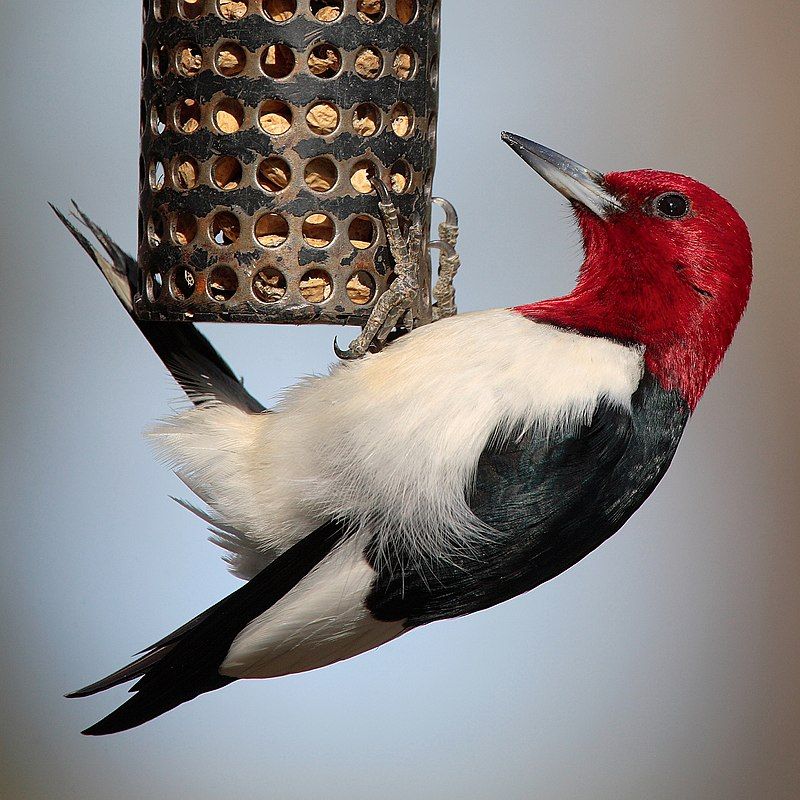
The red-headed woodpecker is a type found in temperate regions of North America. It is not too big or too small, but rather a mid-sized bird. This woodpecker is known for its distinct red head, which sets it apart from other species.
Its vibrant red color stands out against its black and white body. Regarding its habitat, the red-headed woodpecker prefers open areas in southern Canada and the east-central United States. It is specifically found in regions with a moderate climate.
This woodpecker builds its nests during the breeding season in these open country habitats. It looks for suitable spots to create its nest, often choosing dead trees or branches.
The red-headed woodpecker is a skilled excavator, using its strong beak to make holes in the trees for its nests. These holes not only serve as a nesting site but also as a source of food storage.
In addition to nesting, the red-headed woodpecker also searches for food in its breeding habitat. It feeds on various insects, fruits, nuts, and even small vertebrates. This woodpecker is known for its agility and acrobatics.
| Kingdom | Animalia |
| Phylum | Chordata |
| Clade | Dinosauria |
| Class | Aves |
| Order | Piciformes |
| Family | Picidae |
| Genus | Melanerpes |
| Species | M. erythrocephalus |
35. Redhead
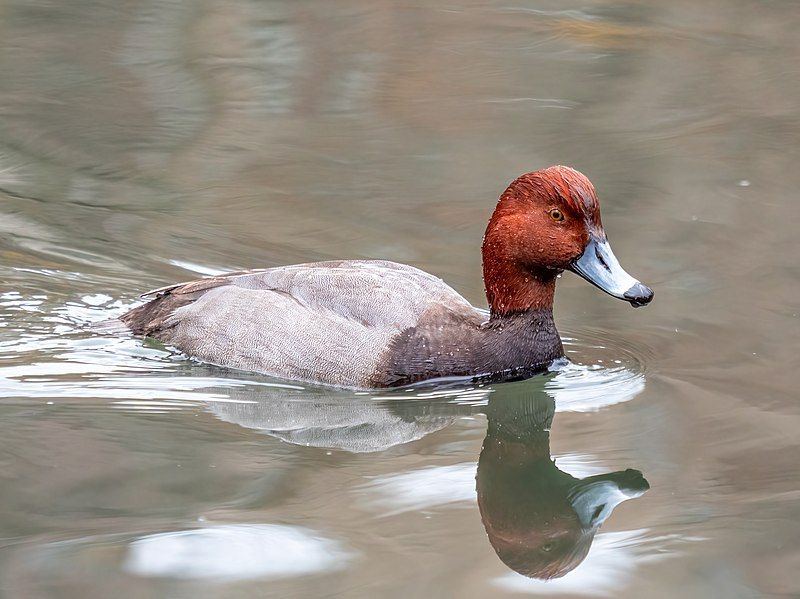
The redhead is a medium-sized duck known for its diving abilities. Its scientific name is derived from two different sources: Greek and Latin. In Greek, the name “Lithuania” refers to an unidentified seabird.
Various authors, including Hesychius and Aristotle, mentioned this bird.
Despite not having a clear identification, this seabird has played a role in shaping the scientific name of the redhead duck. The Latin part of the scientific name, “Americana,” signifies that this duck is associated with America.
It is named so because the redhead duck is commonly found in North America, specifically in regions such as Canada and the United States. Regarding its physical characteristics, the redhead duck measures about 37 centimeters in length.
Additionally, it has a wingspan of approximately 84 centimeters. This size makes the redhead duck fall into the category of medium-sized ducks. The redhead duck’s ability to dive is one of its notable traits.
It can plunge into water to search for food, such as aquatic plants, insects, and small fish. This diving behavior distinguishes the redhead from other ducks that primarily feed on the water’s surface. In conclusion, the redhead duck.
| Kingdom | Animalia |
| Phylum | Chordata |
| Clade | Dinosauria |
| Class | Aves |
| Order | Anseriformes |
| Family | Anatidae |
| Genus | Aythya |
| Species | A. americana |
36. Eurasian Teal
The Eurasian teal is a duck found everywhere across Europe and Siberia. It is also known as the common teal or the Eurasian green-winged teal.
This duck is widespread and can be found in various habitats. During the breeding season in temperate Eurosiberia, the Eurasian teal builds its nests and lays eggs. It prefers areas with suitable vegetation and water sources.
Once the breeding season is over, this duck migrates to warmer regions during the winter. The Eurasian teal travels south in the winter to find more favorable conditions. It is not a permanent resident in these areas but a visitor seeking refuge from the colder climates.
This migration allows the teal to find ample food and survive the harsh winter months. Interestingly, the Eurasian teal is often referred to as simply “teal” in many regions. It is the only small dabbling duck in much of its range.
Dabbling ducks are a group of ducks that feed by upending in shallow water and grazing on vegetation. The teal’s distinctive features, such as its size and appearance, make it easily distinguishable from similar ducks.
Its green-winged teal variation is particularly noticeable.
| Kingdom | Animalia |
| Phylum | Chordata |
| Clade | Dinosauria |
| Class | Aves |
| Order | Anseriformes |
| Family | Anatidae |
| Genus | Anas |
| Species | A. crecca |
37. Cinnamon Teal
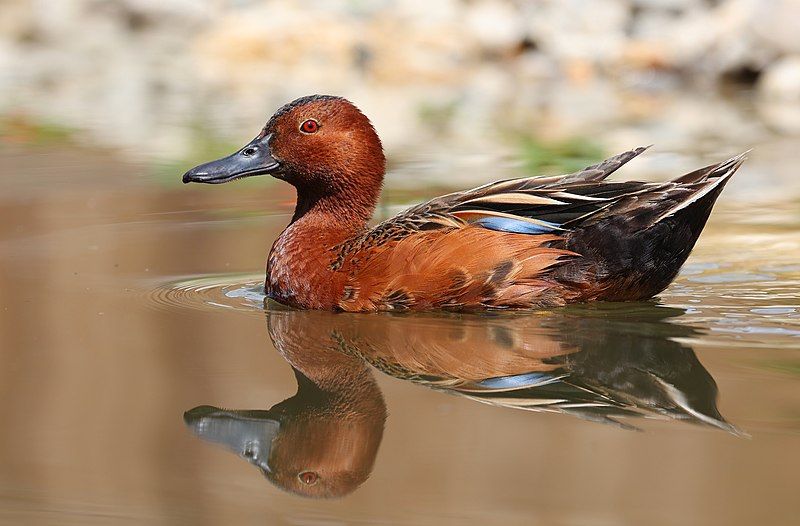
The cinnamon teal is a duck native to western North and South America. It is not a very large duck, but rather a small one.
The male cinnamon teal has a vibrant reddish color on its feathers, while the female has a more subdued brown color. These ducks prefer to live in marshes and ponds, where they can find suitable habitats.
They are dabbling ducks, meaning they feed by dabbling or upending their bodies in shallow water to reach plants and other food sources. The male cinnamon teal stands out with its beautiful reddish plumage, which helps it attract a mate during the breeding season.
The bright color is like a signal to the females that they are strong and healthy potential partners. On the other hand, the female cinnamon teal has a duller brown plumage.
This less showy coloration helps her blend into her surroundings and stay camouflaged while she incubates her eggs or cares for her young. These ducks rely primarily on plants for their nutrition.
They feed on various aquatic plants, grasses, and seeds that they find in their wetland habitats. They use their bills to filter out food from the water and mud. The cinnamon teal is well adapted.
| Kingdom | Animalia |
| Phylum | Chordata |
| Clade | Dinosauria |
| Class | Aves |
| Order | Anseriformes |
| Family | Anatidae |
| Genus | Spatula |
| Species | S. cyanoptera |
38. Ruddy Duck
The paragraph provides information about the ruddy duck, a type found in North America. It also mentions that it belongs to a group called the stiff-tailed ducks.
The paragraph further explains the origin of the genus name and the meaning behind the species name. The ruddy duck is a species of duck that can be found in North America. It is known for its distinctive stiff tail.
This characteristic places it in a group of ducks called the stiff-tailed ducks. The genus name of the ruddy duck is derived from Ancient Greek words.
The word “oxus” means “sharp” in Greek, while “oura” translates to “tail.” Therefore, the genus name of the ruddy duck can be understood as referring to the sharp tail that this species possesses.
The paragraph also mentions the species name of the ruddy duck, “Jamaicensis.” This word is derived from the name of the country Jamaica.
It is used in the species name to indicate that the ruddy duck is “from Jamaica.”The paragraph provides information about the ruddy duck, highlighting its North American origin and classification as a stiff-tailed duck.
It also explains the meaning behind the genus name.
| Kingdom | Animalia |
| Phylum | Chordata |
| Clade | Dinosauria |
| Class | Aves |
| Order | Anseriformes |
| Family | Anatidae |
| Genus | Oxyura |
| Species | O. jamaicensis |
39. Swamp Sparrow
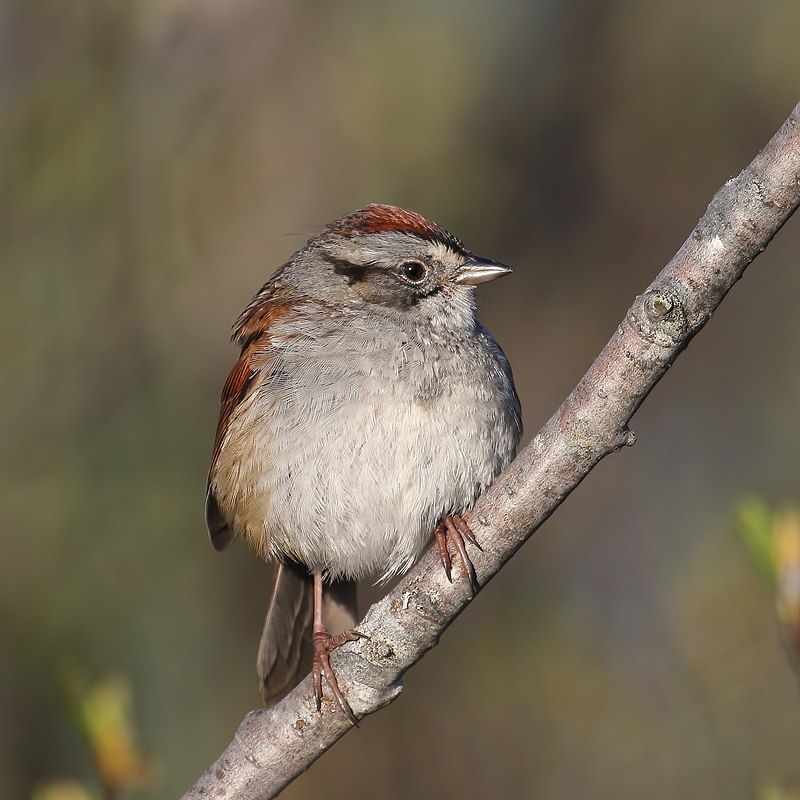
The swamp sparrow is a type of bird known as a sparrow. It is found in the New World, which includes North and South America. This bird is similar to a sparrow called the song sparrow. Both birds belong to the same family or group of birds.
The swamp sparrow is not a very large bird. It is considered to be medium-sized. This means that it is not too big or too small. Its size is somewhere in the middle compared to other birds. The swamp sparrow is found explicitly in swampy areas.
It prefers to live in habitats with many wetlands or marshes. This is because it is well adapted to this kind of environment. It has unique features that help it survive in these wet areas. One exciting thing about the swamp sparrow is its song.
Like the song sparrow, it is known for its beautiful and melodious song. Male swamp sparrows sing to attract mates and establish their territory. Their songs can be heard from the marshes and wetlands where they live.
Despite being related to the song sparrow, the swamp sparrow has unique characteristics. It has distinct plumage or feathers that help it blend in with.
| Kingdom | Animalia |
| Phylum | Chordata |
| Clade | Dinosauria |
| Class | Aves |
| Order | Passeriformes |
| Family | Passerellidae |
| Genus | Melospiza |
| Species | M. georgiana |
40. Ruddy Turnstone

The ruddy turnstone is a type of bird that can be found worldwide. It belongs to a group called wading birds, which means it often lives near water and searches for food in wet areas.
There are two different species of turnstone, and the ruddy turnstone is one of them. Scientists have given the ruddy turnstone a scientific name, Arenaria. This name helps them to classify and study different species of birds.
The ruddy turnstone used to be classified in a different family called the plover family, specifically the Charadriidae family. However, now it is classified in the sandpiper family, known as the Scolopacidae family.
Classification helps scientists understand how different species are related to each other. They are cosmopolitan, which means the ruddy turnstone can be found in many different parts of the world. It is not limited to one specific region or habitat.
This bird is relatively small in size compared to other birds. It has a distinctive reddish-brown color on its feathers, which gives it its name “ruddy.” The turnstone part of its name comes from its behavior of flipping over stones and other objects to find food underneath.
| Kingdom | Animalia |
| Phylum | Chordata |
| Clade | Dinosauria |
| Class | Aves |
| Order | Charadriiformes |
| Family | Scolopacidae |
| Genus | Arenaria |
| Species | A. interpres |
41. Black-Bellied Whistling Duck
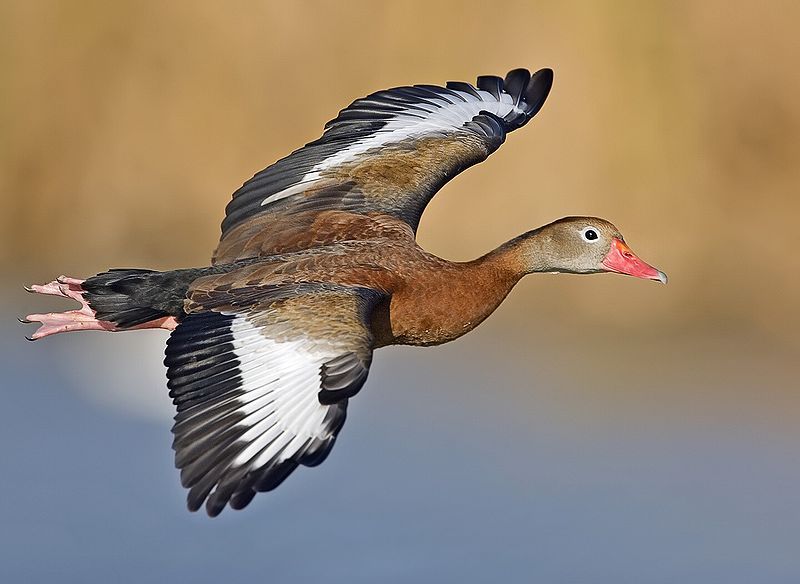
The black-bellied whistling duck is a type of duck that was previously known as the black-bellied tree duck. It is commonly found in various regions, including the southernmost parts of the United States, Mexico, and tropical areas of Central to south-central South America.
This duck species was primarily used to breed in these locations before 2000. However, interestingly, the black-bellied whistling duck can now be found year-round in many parts of the United States.
It doesn’t migrate or move to different regions during specific seasons as other bird species do. The name “whistling duck” comes from the distinctive whistling sound it makes, which is unique and easily recognizable.
This sound is often heard when the duck is in flight or communicating with other members of its species. The black-bellied whistling duck does not have a completely black belly despite its name.
Instead, it has a black belly contrasting with its white underparts and overall grayish-brown plumage. This coloration helps it blend in with its surroundings, providing camouflage and protection. In terms of habitat, the black-bellied whist.
| Kingdom | Animalia |
| Phylum | Chordata |
| Clade | Dinosauria |
| Class | Aves |
| Order | Anseriformes |
| Family | Anatidae |
| Genus | Dendrocygna |
| Species | D. autumnalis |
42. Oystercatchers
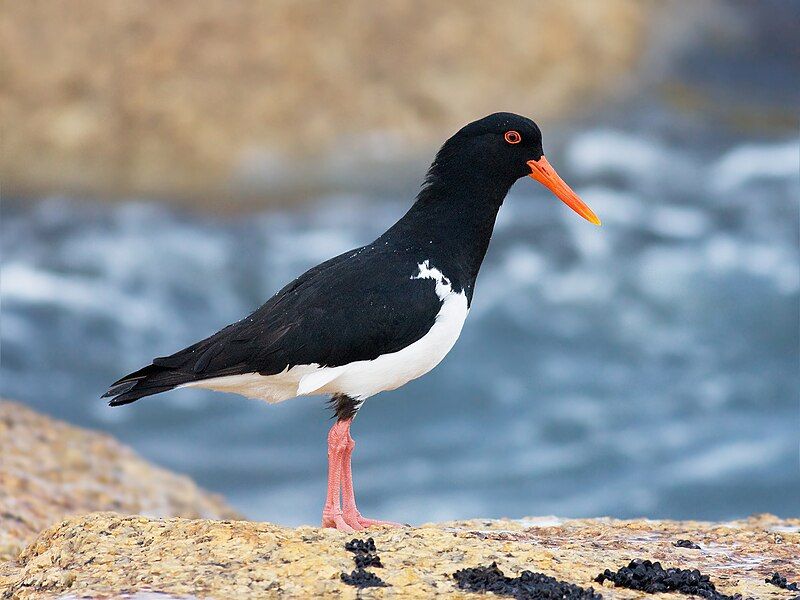
The oystercatchers belong to a family of waders called Haematopodidae. This family consists of only one genus, which is called Haematopus. Oystercatchers can be found in various coastal areas all around the world.
However, they are not present in the polar regions and some specific tropical regions of Africa and South East Asia. Oystercatchers are a unique group of birds known for their distinct appearance and behavior.
These birds have long, stout bills that are specifically designed for feeding on shellfish, particularly oysters.
Hence, their name “oystercatchers” is derived from this feeding habit. The habitat of oystercatchers primarily includes coastal areas, such as beaches, rocky shores, and mudflats.
They are well adapted to live in these environments, as they are excellent swimmers and can easily traverse both land and water.
Oystercatchers are often seen probing the sand or mud with their bills in search of food. These birds prefer a diverse diet, including various marine invertebrates like mussels, clams, worms, and crabs.
They also feed on small fish and even carrion when available.
| Kingdom | Animalia |
| Phylum | Chordata |
| Clade | Dinosauria |
| Class | Aves |
| Order | Charadriiformes |
| Family | Haematopodidae |
| Genus | Haematopus |
43. Peregrine Falcon
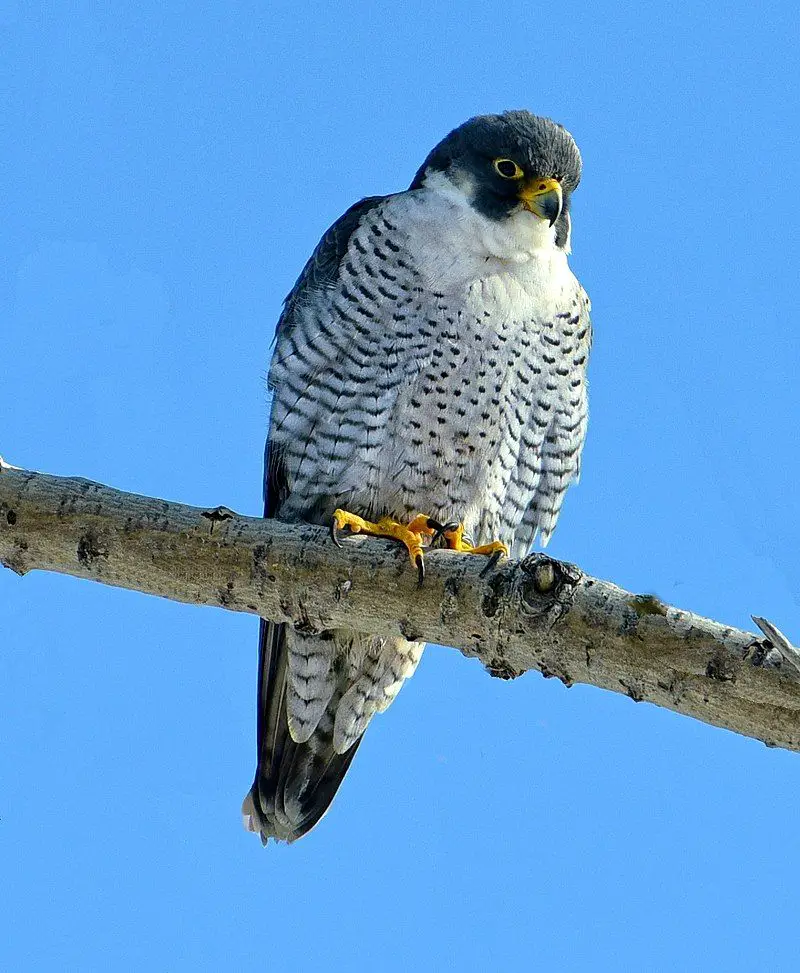
The peregrine falcon is a type of bird of prey that is found all around the world. It is sometimes called the peregrine or the duck hawk in North America. The peregrine falcon belongs to the Falconidae family. One characteristic of the peregrine falcon is its size.
It is pretty significant, similar to the size of a crow. This falcon has a blue-grey color on its back, with white underparts marked with bars. Its head is black. The peregrine falcon is particularly famous for its speed.
It is known to be one of the fastest birds in the world. This falcon can fly at incredibly high speeds while hunting for its prey. Its swift flying ability is genuinely remarkable. Being a bird of prey, the peregrine falcon hunts and feeds on other animals.
It primarily preys on birds, catching them mid-air during flight. This falcon has sharp nails that help it grab and hold onto its prey.
Its hunting technique is both impressive and efficient. The peregrine falcon is a cosmopolitan bird in various parts of the world.
| Kingdom | Animalia |
| Phylum | Chordata |
| Clade | Dinosauria |
| Class | Aves |
| Order | Falconiformes |
| Family | Falconidae |
| Genus | Falco |
| Species | F. peregrinus |
44. American Robin
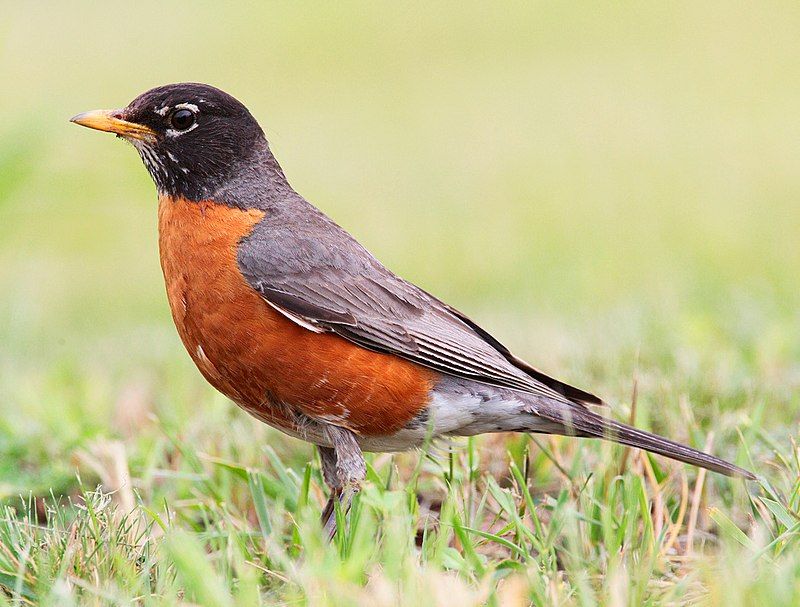
The American robin is a type of bird that migrates. It belongs to the valid thrush genus and the Turdidae family, a more prominent thrush family. It gets its name from the European robin because of its reddish-orange breast.
However, it must be noted that the American and European robin are not closely related. The European robin is a different species and belongs to the Old World flycatcher family.
Despite their similar names and physical characteristics, these two birds are not closely related regarding their genetic makeup.
They may share some similarities in appearance, such as the reddish-orange breast, but their evolutionary paths have taken them in different directions. The American robin is primarily found in North America, while the European robin is native to Europe and parts of Asia.
Both species have adapted to their respective environments and habitats over time.
The American robin is known for its ability to migrate long distances, often traveling south during winter and returning north for breeding season. Regarding physical characteristics, the American robin is larger than the European robin.
It has a grayish-brown back and a distinct reddish-orange breast, a defining feature of the species.
| Kingdom | Animalia |
| Phylum | Chordata |
| Clade | Dinosauria |
| Class | Aves |
| Order | Passeriformes |
| Family | Turdidae |
| Genus | Turdus |
| Species | T. migratorius |
45. Ruby-Throated Hummingbird
The ruby-throated hummingbird is a type of hummingbird that has a bright red throat. This species is known for its unique migration pattern. These hummingbirds can be found in Central America, Mexico, and Florida during the winter months.
They choose these warmer regions because they provide a more suitable climate for survival. However, the ruby-throated hummingbird embarks on an incredible journey when the summer season arrives.
They migrate to Canada and other parts of Eastern North America to breed.
This long-distance migration allows them to take advantage of the abundant resources available in these areas during the summer months. The reason behind this seasonal migration is quite fascinating.
In Central America, Mexico, and Florida, the ruby-throated hummingbirds find a variety of nectar-producing flowers that provide them with a sufficient food source.
These flowers bloom during the winter, ensuring the hummingbirds have enough energy to survive. But as the seasons shift and the temperatures rise, the flowers in these regions begin to wither away.
This scarcity of food prompts the hummingbirds to undertake their impressive journey northward. They instinctively know that Canada and Eastern North America offer abundant nectar-producing flowers during the summer, which is ideal for them.
| Kingdom | Animalia |
| Phylum | Chordata |
| Clade | Strisores |
| Class | Aves |
| Order | Apodiformes |
| Family | Trochilidae |
| Genus | Archilochus |
| Species | A. colubris |
46. Northern Flicker
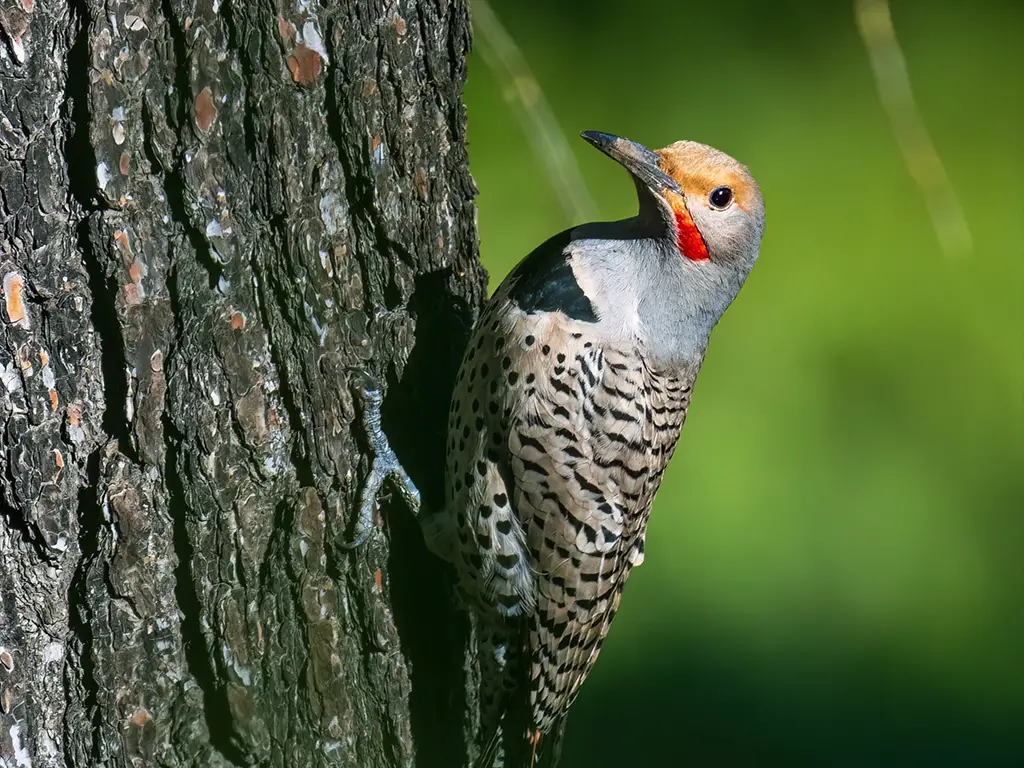
The northern flicker is a bird that belongs to the woodpecker family. It is not a very large bird but also not too small. The northern flicker can be found in many parts of North America.
It is also native to some areas in Central America, such as Cuba and the Cayman Islands. One exciting thing about the northern flicker is that it is one of the few woodpecker species that migrate.
Migration means these birds travel from one place to another during different seasons. They do this to find food and suitable habitats.
The northern flicker migrates to different regions depending on the time of year. During the breeding season, which is usually in the spring or summer, the northern flicker can be found in many parts of North America.
They build their nests in trees and use their strong beaks to create holes in the wood. These holes are called cavities and serve as their homes. Northern flickers are known for their distinctive markings.
They have a brown body with black spots, and their wings have a white patch easily visible when flying. Another unique feature is the red or yellow coloration on the underside of their wings and tail.
| Kingdom | Animalia |
| Phylum | Chordata |
| Clade | Dinosauria |
| Class | Aves |
| Order | Piciformes |
| Family | Picidae |
| Genus | Colaptes |
| Species | C. auratus |
47. Pileated Woodpecker
The pileated woodpecker is a type of bird that is primarily black and is found in North America. It is a relatively large bird compared to other woodpeckers. The pileated woodpecker mostly eats insects, which makes it an insectivore.
It usually lives in deciduous forests located in eastern North America. In addition to the east part of North America, the pileated woodpecker can also be found in the Great Lakes region. It can be seen in Michigan, Minnesota, and the surrounding states.
The bird is also found in the boreal forests of Canada. These forests are characterized by primarily coniferous trees and are located in northern Canada. Furthermore, the pileated woodpecker can be spotted in certain areas along the Pacific Coast.
This means it can be found in states like Oregon and Washington. Interestingly, the bird’s habitat spans different regions, showing its adaptability to various environments.
Overall, the pileated woodpecker is a fascinating bird native to North America. Its black feathers and relatively large size make it easy to identify. It prefers to live in deciduous forests.
| Kingdom | Animalia |
| Phylum | Chordata |
| Clade | Dinosauria |
| Class | Aves |
| Order | Piciformes |
| Family | Picidae |
| Genus | Dryocopus |
| Species | D. pileatus |
48. Dark-Eyed Junco
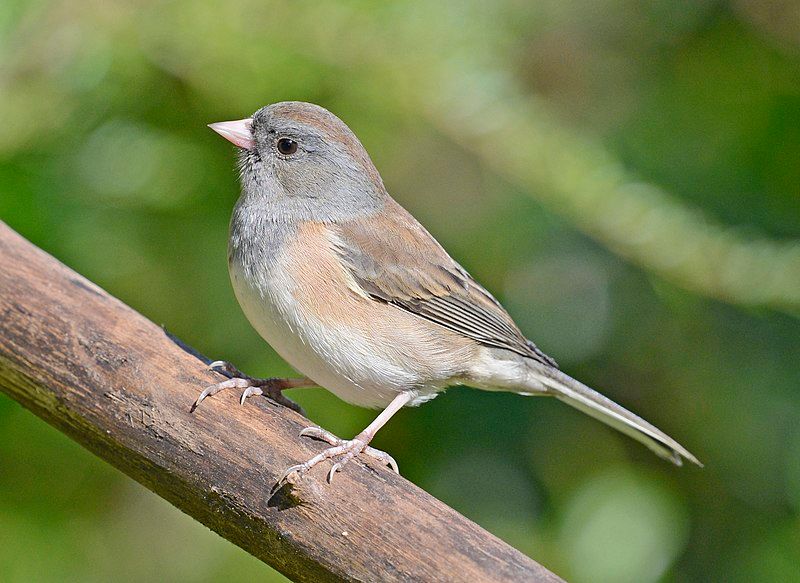
The dark-eyed junco is a type of bird called a junco. Juncos are small, grayish sparrows that live in the New World. The dark-eyed junco is found in many parts of temperate North America; during the summer, it even goes as far as the Arctic.
The dark-eyed junco is a species that has a lot of variation. This means that different individuals of this bird can look quite different from one another. It is similar to another species of sparrow called the fox sparrow in terms of its variability.
Despite being studied by scientists, the systematics of the dark-eyed junco are still not fully understood. Systematics refers to exploring the relationships between different species and their classification.
So, even though researchers have been trying to figure out how the dark-eyed junco fits into the larger picture of bird species, there are still some unanswered questions.
| Kingdom | Animalia |
| Phylum | Chordata |
| Clade | Dinosauria |
| Class | Aves |
| Order | Passeriformes |
| Family | Passerellidae |
| Genus | Junco |
| Species | J. hyemalis |
49. Common Blackbird
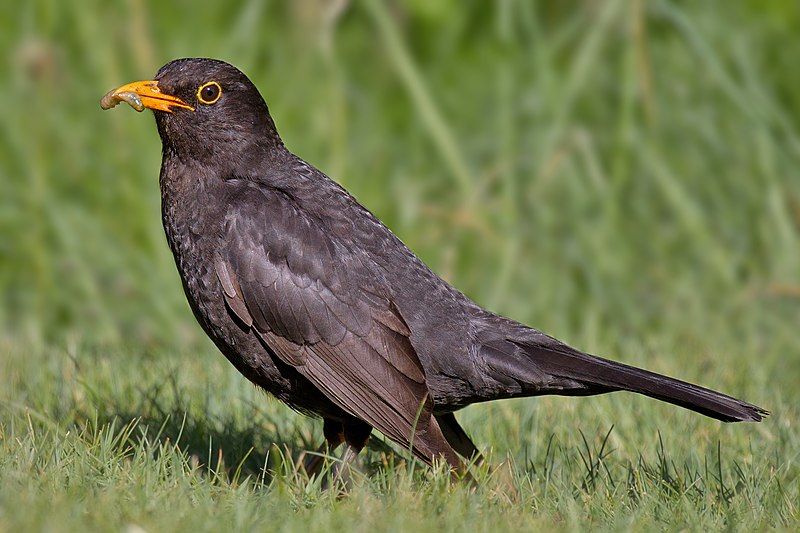
The common blackbird is a type of bird known as a true thrush. It is sometimes referred to as the Eurasian blackbird or simply the blackbird. This is done to avoid any confusion with another similar-looking local bird species.
The common blackbird is found primarily in Europe, Asiatic Russia, and North Africa. It is known to breed in these regions, reproducing and raising its young there. Interestingly, the common blackbird has also been introduced to other parts of the world.
Specifically, it has been brought to Australia and New Zealand. Humans likely made these introductions and transported the birds to these new locations.
Overall, the common blackbird is a widespread species found in different regions across the globe.
It is known for its distinctive appearance and is often called by different names depending on the location.
| Kingdom | Animalia |
| Phylum | Chordata |
| Clade | Dinosauria |
| Class | Aves |
| Order | Passeriformes |
| Family | Turdidae |
| Genus | Turdus |
| Species | T. merula |
Conclusion
During the colder months, winter birds in Texas bring a vibrant and diverse array of species to the state.
From migrants from northern North America to resident species adapting to the changing climate, Texas offers a haven for a wide variety of wintering birds.
The state’s diverse ecosystems, including wetlands, forests, and coastal regions, provide abundant food and shelter for these winter visitors.
As birdwatching becomes an increasingly popular activity, Texas offers enthusiasts the opportunity to observe and appreciate the beauty and unique behaviors of these winter birds.
The conservation efforts and protection of habitats in Texas are crucial in ensuring these species’ continued well-being and survival.
Overall, winter birds in Texas contribute to the state’s rich biodiversity and provide an exciting and rewarding experience for both birdwatchers and nature enthusiasts alike.